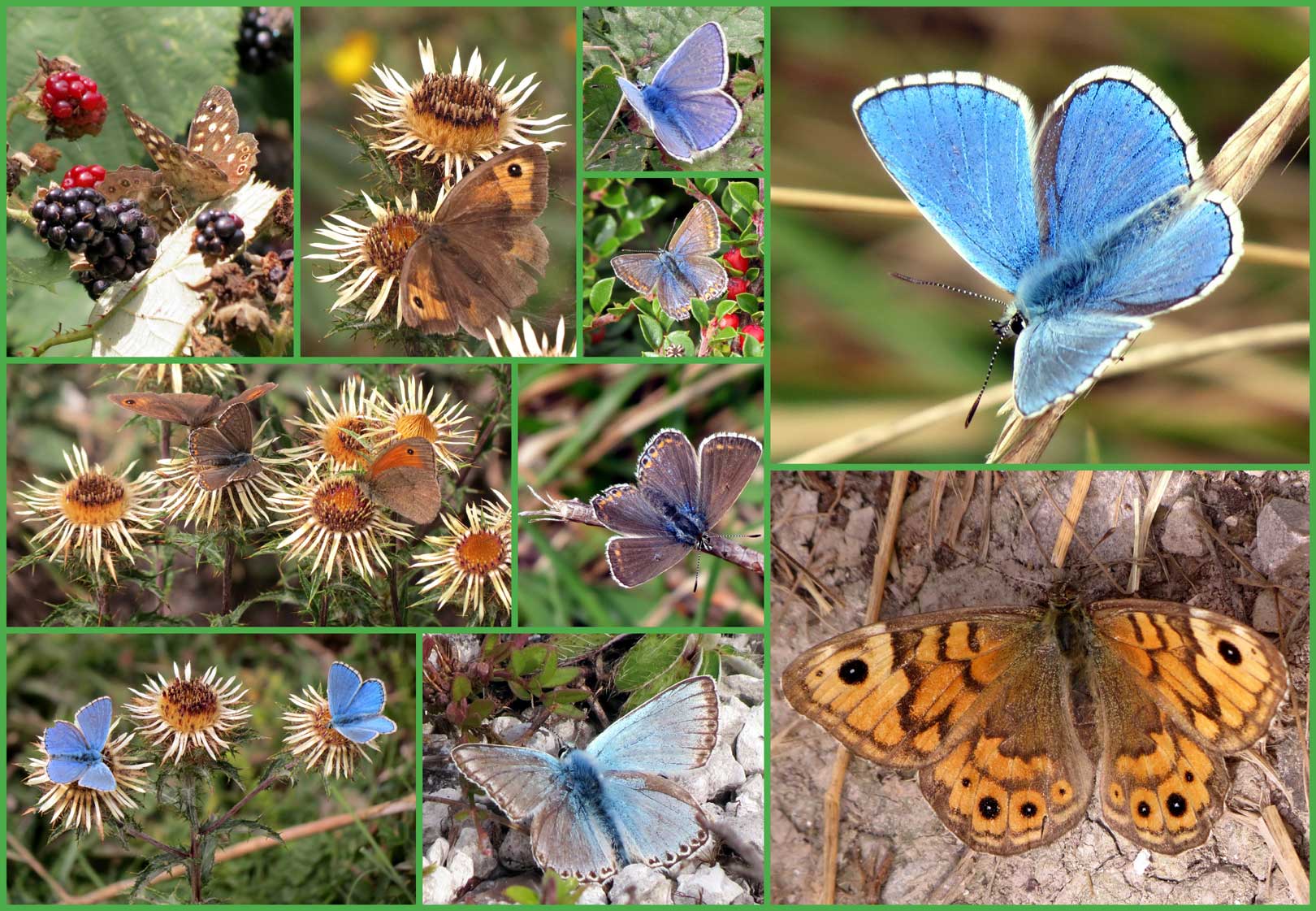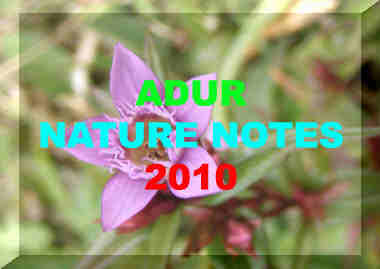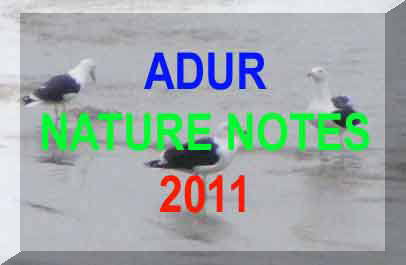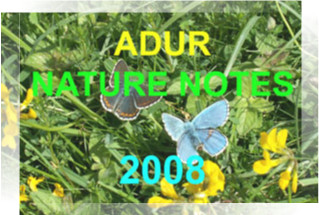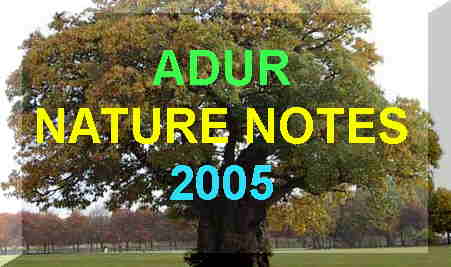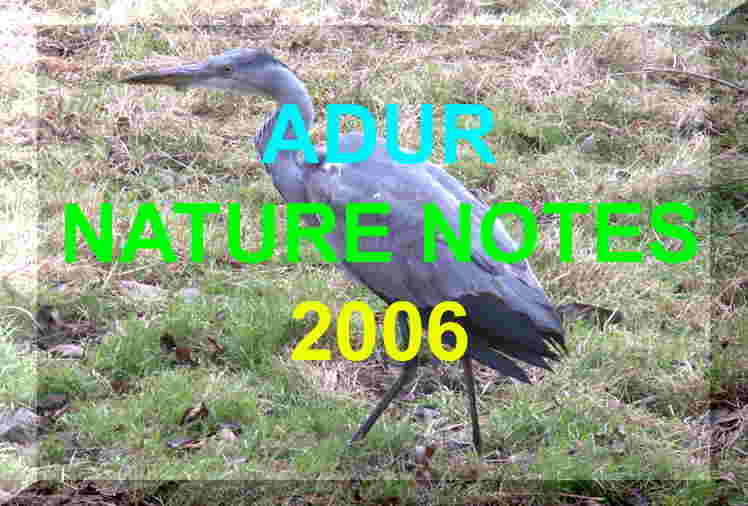 All
observations by Andy Horton, unless stated otherwise.
All
observations by Andy Horton, unless stated otherwise.|
|
|
|
|
|
|
|
|

Sussex
Butterfly Reports (Butterfly Conservation Society)
UK
Butterflies: Sightings
Adur
Butterfly Species
Adur
Moths
Adur
Butterfly Flight Times
Adur
Butterflies: First Dates
Adur
Skippers
Adur
Nature Notes 2011
Adur
Butterfly List 2010
Adur
Butterfly List 2011
Adur
Butterfly List 2012
UK
Butterflies & Moths (alphabetical order by common name)
Sussex
Moth Group Sightings
Diapause
(=hibernation)
WILDLIFE
REPORTS
(Narrative):
Adur Butterfly List 2014 (Link)
30
December 2013
A
Red
Admiral Butterfly was seen in Shoreham.
1
December 2013
I
looked into my outside shed and the Small
Tortoiseshell Butterfly was still there,
wings folded in diapause.
This was my first record of this butterfly
for December.
I
have not included it in the flight times
worksheet because it has remained stationary.
Adur
Butterfly Flight Times
27
November 2013
A
most unexpected discovery was a Small Tortoiseshell
Butterfly asleep on my bedroom wall. Without
my spectacles on I thought it must have been a spider
and I gave it a nudge. Sleepily, I cupped it in my hand as I did not recognise
it as a butterfly
at first. It was after I recognised what it was, I took the butterfly to
my small empty plastic aquarium tank in my bathroom. Then the butterfly
came to life and flew around the light bulb. I caught it again and by midday
the butterfly is resting with its wings closed in the small aquarium. It
looked worn but it did not appear to have any obvious damage.
Diapause
(=hibernation)
13
November 2013
One
sunny still day with hardly a breeze, a Red
Admiral flew across a very crowded Adur
Ferry Bridge and a short time after one flew across the River
Adur adjacent to the very new bridge.
4
November 2013
In
the warm sunshine there were Red Admirals
and a Comma
on fallen apples in the garden where I work north of Shoreham
Airport and a Humming-bird Hawk-moth
on Verbena bonariensis
(TQ 196063).
Later cycling home to Brighton a Red Admiral
accompanied
me some of the way along Basin Road South near Shoreham Power station despite
it being almost dusk.
A
Common
Darter (dragonfly)
was seen over the Pixie Path and I immediately
thought that it might be my total interest as winter
seemed to have set in. Immediately afterwards a Red
Admiral flew northwards from Frampton's
Field in a few minutes of weak sunshine. I visited Mill
Hill after the recent rain along muddy paths which were sticky but
not treacherous. I was thinking it was hardly worth the trek to the lower
slopes as there was hardly a plant in flower
and nothing moving apart from the common birds.
 |
 |
 |
Just
as I was about to leave I spotted a flash of yellow out the corner of my
eyes and it was not one of the many leaves that fluttered a bit like a
butterfly
in the gentle breeze. It was the first of three Clouded
Yellow Butterflies, of which
two appeared to be courting, despite the faintest chill (>9.8
°C) in the air after
the warmest
October in my
memory. I disturbed the resting butterflies
and they flew up rapidly over the steep slopes above the muddy path.
 |
30
October 2013
Two Red Admirals were seen flying over Adur Recreation Ground, one of them near the Railway Viaduct. 29
October 2013
|
26
October 2013
A
Red
Admiral flew or was blown over St. Mary's
Road, central Shoreham.
 23
October 2013
23
October 2013
After
the over night rain deluge, the weather cleared and there
was even a enough warmth for the surviving butterflies
to be discovered in the breeze.
Just three definite butterflies were actually seen: a flighty Red
Admiral over the Waterworks
Road, Old Shoreham; a resting Comma
on the Pixie Path; and lastly a restless Clouded
Yellow over the lower slopes of Mill
Hill. There was also a possible Small
White and a possible Large
White but both were caught in a gust and blown
away too quickly to be sure.
Three
definite butterflies
20
October 2013
There
were no butterflies
on a trip to Mill Hill via the Pixie
Path. It was cloudy with no glimpse of
sunshine and in the early afternoon it began to rain heavily. The temperature
fell to 12.3 °C
by the time I reached the lower slopes of Mill Hill.
 15
October 2013
15
October 2013
It
was muddy underfoot but the sun shone intermittently through gaps in the
clouds. I was surprised by a Red
Admiral and a Clouded
Yellow Butterfly flying over the Sea
Aster at low tide
over the River Adur
estuary between Ropetackle and Old Shoreham. On the Pixie
Path I added two Comma Butterflies,
two Speckled Woods
and another three Red Admirals.
This made me anticipate more butterflies
on Mill Hill. A Red
Admiral was quickly seen over the road before
(south of) the first cattle grid. Mill Hill was in both shade and sunshine,
but the sunshine was very weak for the first twenty minutes when I failed
to spot a single butterfly in flight. I was about to register a blank when
my eye caught a very bright Clouded Yellow
that was settled before it flew off rapidly. It was the first of two seen
on the lower slopes. The sun could be felt for the first time and almost
simultaneously I disturbed the first of seven Meadow
Browns, and later just the one Small
White Butterfly. There may be more butterflies
in hiding as it was only warm enough for butterflies for about ten minutes.
One Meadow Brown
was
disturbed into flight by the frequent
grasshoppers.
Later
in Shoreham, I noted another Small White Butterfly.
21
butterflies of six species
| 12
October 2013
A splendid study of an immigrant male Long-tailed Blue Butterfly is captured on the north bank of Southwick Canal (Shoreham Harbour) opposite the power station. A Speckled Wood Butterfly and a Small White were seen simultaneously on the Downs Link Cyclepath |
 |
10
October 2013
With
a l cold north wind and a cloudy sky, the
only butterfly seen was a Red
Admiral on the outskirts of Lancing, on
the verge of the main road opposite the Sussex Pad.
9 October
2013
Four
Long-tailed
Blue Butterfly (three males & a female)
were seen on the north bank of Southwick Canal (Shoreham Harbour)
opposite the power station up until 12.30
pm when it clouded over. The best area for
them seems to be by the small brick shelter next to the A259.
8
October 2013
Another
pleasant day for a trip up the downs: on the
way up to Mill Hill I noted a few Large
Whites by the River
Adur, a Small
White in Old Shoreham, a Red
Admiral in the the Butterfly Copse by
the Waterworks
Road, and a Comma
at the top of the Pixie Path. This
time the sun went behind a cloud as I descended
to the lower slopes of Mill Hill, where it is was five minutes before the
first of ten Meadow
Browns made an appearance. All but two
seen in the transect acre
were at the northern end. One pair continued copulating in flight when
disturbed. The northern end of the lower slopes was also attractive to
a female Common Blue,
a faded Small Copper
(a different one from seen two days earlier) and
a much brighter Clouded Yellow
than seen before. On my return a Speckled
Wood Butterfly was seen at the top of
Chanctonbury Drive (SE of Mill Hill Road Bridge over the A27).
Nine
butterfly species
7
October 2013
A
peregrinating
trip to Anchor Bottom and back via towpath
and Downs Link Cyclepath produced a few
Large
Whites, at least one Small
White, a Comma
and a Speckled Wood.
Shoreham town added a Red
Admiral.
Five
butterfly species
 6
October 2013
6
October 2013
A
fresh male Long-tailed Blue Butterfly
visited the large clump of Ivy outside
Shoreham Cement Works, Upper Beeding (TQ
199 086) between 11.35
am and 11.45 am. It then flew east, back over
the fence into the Everlasting Peas
within the Cement Works. This was the first
record of this immigrant butterfly on these Nature
Notes pages. The Ivy
also hosted 3 Red Admiral
and 2 Comma
and nearby was a Small White
and a Speckled Wood.
Under
a mixed cloudy sky, it was warm enough for
the few remaining butterflies
to come out in the sunshine. At least four Speckled
Woods were seen in the shade of bushes
and trees at the top of Chanctonbury Drive (SE of Mill Hill Road Bridge
over the A27).
The
sun then disappeared behind a cloud and did not reappear until I was on
the lower slopes of Mill Hill. Meadow
Browns were the first butterflies to be
seen and this trek I counted 19 in the one
acre transect in about half an hour and more
after I stopped counting. All but one of the butterflies were congregated
at the northern end but other species were sparse in numbers with just
two Small Heath Butterflies,
a Large White,
and two brown females, one each of Common
Blue and Adonis
Blue. Pride of place was given to a good
condition Small Copper.
A restless Clouded Yellow
was the one exception as it fluttered continually the full length of the
lower slopes and back. A Small White
was noted as I returned by the winding path through the lower slopes.
Another
Small
White was seen in Shoreham and another Clouded
Yellow by the Holmbush roundabout.
Eight
butterfly species (my tally only)
2
October 2013
In
Shoreham town there was a least one Small
White Butterfly on an overcast day with
brief spells if sunshine. The Pixie Path
route to Mill Hill added a Speckled Wood
and a Red Admiral.
On Mill Hill Road , north of the bridge, I spied a Dark
Bush Cricket by the hedge. Venturing down
to the dry lower slopes of Mill Hill, the
first of over a dozen Meadow
Browns fluttered around more rapidly than
usual. Even more restless was two sightings of a Clouded
Yellow (a half an hour apart) which may
have been the same butterfly. Of note was
a large brown butterfly which I suspected was a female Adonis
Blue.
There was also a probable male Adonis Blue
as well as a female Common Blue.
The difficulty of identification was because the butterflies edges were
tattered. The identification was made on size and brightness of the blue
and on previous appearances.
 |
 |
 |
|
|
|
|
 Most
butterflies were at the northern end by the Devils
Bit Scabious, where a fresh Large
White Butterfly fluttered around. There
appeared to be a shortage of nectar plants.
Meadow
Browns
used the Devils
Bit Scabious and
Bramble and made a fleeting visit to Wild
Basil. There was also a an orange-brown moth
that flew from the ground to hedgerow height and disappeared. I have seen
these before in September
and
they have never been positively identified, although they could be Vapourer
Moths?
Most
butterflies were at the northern end by the Devils
Bit Scabious, where a fresh Large
White Butterfly fluttered around. There
appeared to be a shortage of nectar plants.
Meadow
Browns
used the Devils
Bit Scabious and
Bramble and made a fleeting visit to Wild
Basil. There was also a an orange-brown moth
that flew from the ground to hedgerow height and disappeared. I have seen
these before in September
and
they have never been positively identified, although they could be Vapourer
Moths?
Eight
butterfly species
29
September 2013
When
the sun came out so did a few of the more notable flying insects including
at least seven Comma Butterflies
and a few Speckled Woods
in the shade, as well as a few Small White
Butterflies and at least one Large
White Butterfly on the Downs
Link Cyclepath from Old Shoreham to Upper Beeding. A Common
Darter (dragonfly)
was seen at Upper Beeding and a Southern
Hawker at the southern edge of the Salting's
Field at Bramber by the River
Adur. A splendid large hoverfly
Volucella zonaria, settled on a flowering
Buddleia on the cyclepath by the Cement
Works. There were a few small orange-brown moths
which might be Vapourer Moths
??? but these were not seen close-up.
23
September 2013
A
tattered female Common Blue
was seen on the Widewater
margins visiting a Yarrow
flower,
with a few Large Whites.
| 20
September 2013
After the rain and the near Gale, the day was fine, overcast with intermittent sunshine. Orb Spiders had spun a deadly trap of threads over the Brambles and there seemed hardly any refuge for the butterflies that remained. Large Whites were frequent enough and there were a few Small Whites as well. A Comma Butterfly was spotted resting on Brambles between the webs on the verge of the Waterworks Road. A Holly Blue was seen around the Ivy on the Pixie Path to Mill Hill with at least three Speckled Woods on the path and road to the downs. |
|
 |
| The
lower slopes of Mill Hill were
cast in shade as the clouds blocked out the rays of sun.
There no butterflies at all for nearly five minutes, just hundreds of grasshoppers
jumping everywhere I stood and scores of Crane-flies
over the short vegetation. Meadow
Browns were the first butterflies to appear,
with about eight of them scattered over the first
half half acre of the transect. A few Treble-bar
Moths attracted my attention as I disturbed
their resting place. A very tattered large brown butterfly was probably
a female Adonis Blue.
This was followed a smaller intact brown butterfly which I identified as
a female Common
Blue,
followed by another female
and blue male
of the same species.
The
butterflies were not attracted to the Carline
Thistle. However, at the northern end of the
lower slopes there are three clumps of Devil's
Bit Scabious growing close together and these
provided a first class attraction for about 25 more Meadow
Browns
and
about four Common
Blues
and a female Adonis Blue quarrelling
over the available flowerheads. The dozen Large
Whites over Mill Hill did not get a chance.
And that seemed to be it, perhaps fo the year until a restless Clouded
Yellow flew by without pausing. There
were more Meadow
Browns as I returned by the winding path through
the lower slopes.
|
|
 |
| 16
September 2013
Under an overcast sky I spotted two Speckled Woods and a few Small Whites on the outskirts of Steyning. Earlier in the day I spotted Large Whites in the distance. A Southern Hawker, (dragonfly) flew about and then settled high up in the trees. |
 |
13
September 2013
Just
occasional Large Whites,
at least two Small Whites
and a Meadow
Brown were seen in and around the urban
streets of Shoreham, Shoreham Beach and Southwick.
The
sky was overcast and the non-flowering Buddleia
was visited by flocks of Starlings,
one flock counted at 66 strong.
12
September 2013
It
was not warm enough for many butterflies
and I only saw a few Large Whites
on the outskirts of Shoreham and no butterflies at all on Mill
Hill Cutting (SW). It was not in my plan in the late afternoon to visit
the lower slopes of Mill Hill, but I thought
I would record what could (probably not) be my last butterflies of the
year. The idea was to see my last blue butterfly and then go home. In the
event I had to quickly trek nearly the whole
acre transect recording twenty Meadow
Browns, ten Treble-bar
Moths, one Small
Heath Butterfly, before I saw my first
Common
Blue resting on Devil's
Bit Scabious. It was only on the way back
along the winding path that I saw a male Adonis
Blue.
Five
butterfly species and a macro-moth
 11
September 2013
11
September 2013
There
were so many Sparrows
and Starlings
in the Buddleia
bushes between Ropetackle and Old Shoreham, that I am surprised there were
occasional Large White Butterflies
and a few Small Whites
that escaped their feeding attentions. I spotted a Red
Admiral on the Buddleia
by
the Buffer Stop and a Holly Blue
visiting Bramble flowers. The same pattern
of the absence of butterflies
was repeated on the Downs Link Cyclepath
between Old Shoreham and the Cement Works, although the birds were not
omnipresent. More Large Whites
on Buddleia and
a few Speckled Woods
on the leaves only were seen on the outgoing cycle journey. At Anchor
Bottom (Dacre Gardens entrance) I added a half a dozen each of Meadow
Browns and Adonis
Blues
and a few Common Blues.
There was also a possible Peacock Butterfly
over
the cyclepath, but it might have been another Red
Admiral.
Eight
butterfly species (possibly nine)
9
September 2013
After
the torrential rain in the previous day and
on an overcast day I expected the butterflies
to be diminished in numbers and variety and it was as expected in the same
proportions as before. Speckled Woods (3)
were the first appear on the steps down to the lower slopes of Mill
Hill from the south. Adonis Blues
showed quickly and tallied up to 24 in the transect
acre. About half were
females. Meadow
Browns could be counted in the transect
acre at 57 with females
more than males.
 |
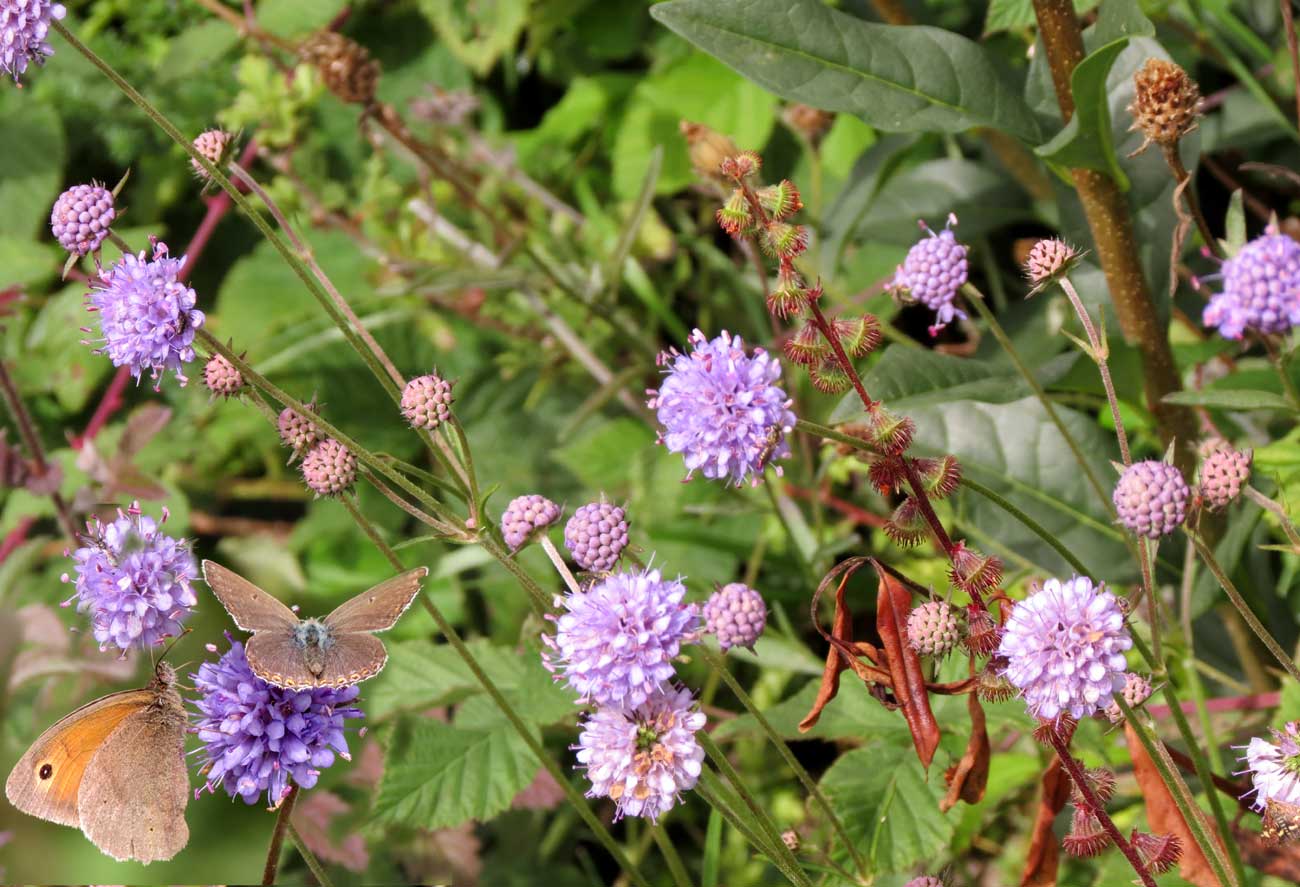 |
 |
Carline
Thistle was not the attractant. Only Devil's
Bit Scabious proved
a major nectar source with a few Hardheads
and a Dwarf Thistle attracting
Meadow
Browns. There were four Small
Heaths behaving as usual. Common
Blues
were
not counted but there were about a dozen on the lower slopes with a few
Large
Whites and a restless Clouded
Yellow. Day flying moths
were more than expected with a few Shaded
Broad-bar (4), about eight Treble-bars,
at least one pyralid
moth Pyrausta purpuralis,
and a Silver Y Moth.
I
returned by the ridge route and spotted at least twenty Meadow
Browns,
another
half a dozen or more Common Blues and
Large
Whites without trying.
Seven
butterfly species and four day-flying moths
5
September 2013
On
a very sunny afternoon under a blue sky, I
cycled on the Downs Link Cyclepath northwards
from Old Shoreham, noting the autumnal feel, with hundreds of grasshoppers
on the meadow-like verges, and scores of Large
White and Small
White Butterflies attracted to the Buddleia.
I spotted just the one Brimstone Butterfly. Speckled
Woods (20+) were frequently seen in the
shady spots with occasional Common Blues
in the sun..
Although,
it was not planned to decided to cycle to the Steyning Nature Trail west
of the country town. I left my bike locked next to a gate and I walked
up the hill seeing more (about seven) Speckled
Woods in the woods, and immediately spotting
a Wall Brown
followed by a Clouded Yellow in
the second meadow past the second gate higher up the hill. These two were
followed by a few Meadow
Browns and higher up the hill near the
third gate there were swathes of Devil's Bit
Scabious which proved attractive to frequent
Common
Blues.
There was also a few closed Yellow Wort flowers
and at least one Carline Thistle
so this may be on chalk. It looked a promising area but there were not
many butterflies
to be seen. Two Buzzards
soared overhead. Returning down the footpath lined with hedges both side,
all the flutterings were even more Speckled
Woods.
Eight
species of butterfly
3 September 2013
Speckled Woods in Buckingham Park
1
September 2013
An
afternoon visit to Mill Hill on the the
day of Shoreham Air Show
was a little overcast by the afternoon.
The
approaches to Mill Hill the from the Waterworks
Road produced the inevitable Large
White Butterflies and Small
Whites with more than expected frequent
Speckled
Woods and occasional Holly
Blues and Meadow
Browns along the Pixie
Path. Mill Hill Cutting (SW) hosted just two male and five female Chalkhill
Blues
seen
although I expect there were more. There was a female Adonis
Blue but no males and a handful of Common
Blues.
The
upper part of Mill Hill was crowded with picnickers so I only visited the
lower slopes and it appears that this year I have missed the second brood
peak of the Adonis Blues
with
a reduction from the last visit to 49 (35 males
and 14 females).
Chalkhill
Blues
were
almost finished with just four males
seen in the transect acre
and a female.
Wall
Browns impressed with five seen, four
of them in fine condition, and in addition there was an estimated 80 Meadow
Browns, frequent Common
Blues,
occasionalSmall Heaths,
a few Speckled Woods
on the southern steps, occasional Large Whites
and Small Whites,
a few Treble-bar Moths,
and at least one faded pyralid
moth
Pyrausta nigrata. Autumn is here and
the butterfly
season was nearly over.
NB:
On Mill Hill
there was difficulty in separating the female Adonis
Blues and Chalkhill
Blues. There may be more female Chalkhill
Blues than I first thought.
Nine
butterfly species
 |
30
August 2013
My first trip up the downland to the west of Steyning in the midday sunshine produced hardly any butterflies in unfamiliar territory of conservation grazed cattle pasture of downland and woods on the hill above Steyning Bowls Club. I approached from the Mouse Lane north end and after a long walk of about half an hour or more, I spotted a Southern Hawker (dragonfly) and nothing at all of interest except a shiny black beetle the Bloody-nosed Beetle, Timarcha tenebricosa. The two hour long climb and I saw under thirty butterflies of the species Large Whites, Small Whites, Meadow Browns, Speckled Woods, Holly Blues, Common Blues, occasional Small Heaths, one Wall Brown and a single Small Tortoiseshell. It was decidedly unpromising from start to finish. The variety of flora was exiguous although I did note my first Devil's Bit Scabious this year and three Harebells. A Green Woodpecker flew into a clear view on three occasions. The view had a novelty value and was reasonably attractive. Nine butterfly species |
 |
29
August 2013
On a warm breezy day, I made detour on the outskirts from Old Shoreham via the Waterworks Road on Footpath 3138 to Mill Hill Cutting (SW) and up the Pixie Path and back home through the Dovecote Estate. The butterflies seen were the frequent Large Whites and Small Whites, with a tattered Comma added on the edge of the Waterworks Road, with a few Speckled Woods. Frampton's Field and the path hosted Meadow Browns. Amongst the Ivy and Brambles there was a Holly Blue. On Mill Hill Cutting, there were at least seven Chalkhill Blues including at least two females, with one seeing depositing an egg, but alas, not on the leaves of Horseshoe Vetch. Common Blues fluttered around on the chalk embankment. A Red Admiral over and one was seen before in Shoreham. And then was the mystery brown butterfly photographed on the left which I have tentatively identified as a female Adonis Blue. There is a snag as no males were seen in the small area on the day and no females have been seen in the immediate area in previous years. Eight butterfly species and one probable making nine |
 28
August 2013
28
August 2013
There
were many white butterflies,
Large Whites and Small
Whites, and a few Holly
Blues in Shoreham.
I
ambled over the parched upper part, top meadows and middle slopes of Mill
Hill, without any special searching and I saw over a hundred Meadow
Browns, many of them amorous, at least
39 (36+3) Adonis Blues
including courting couples, double as many Common
Blues,
a handful of Chalkhill
Blues with some fresh males, five Wall
Browns, occasional Small
Heaths, frequent Speckled
Woods, one Peacock
and one restless Clouded Yellow.
I declined to visit the lower slopes under the midday
sun.
Twelve
butterfly species
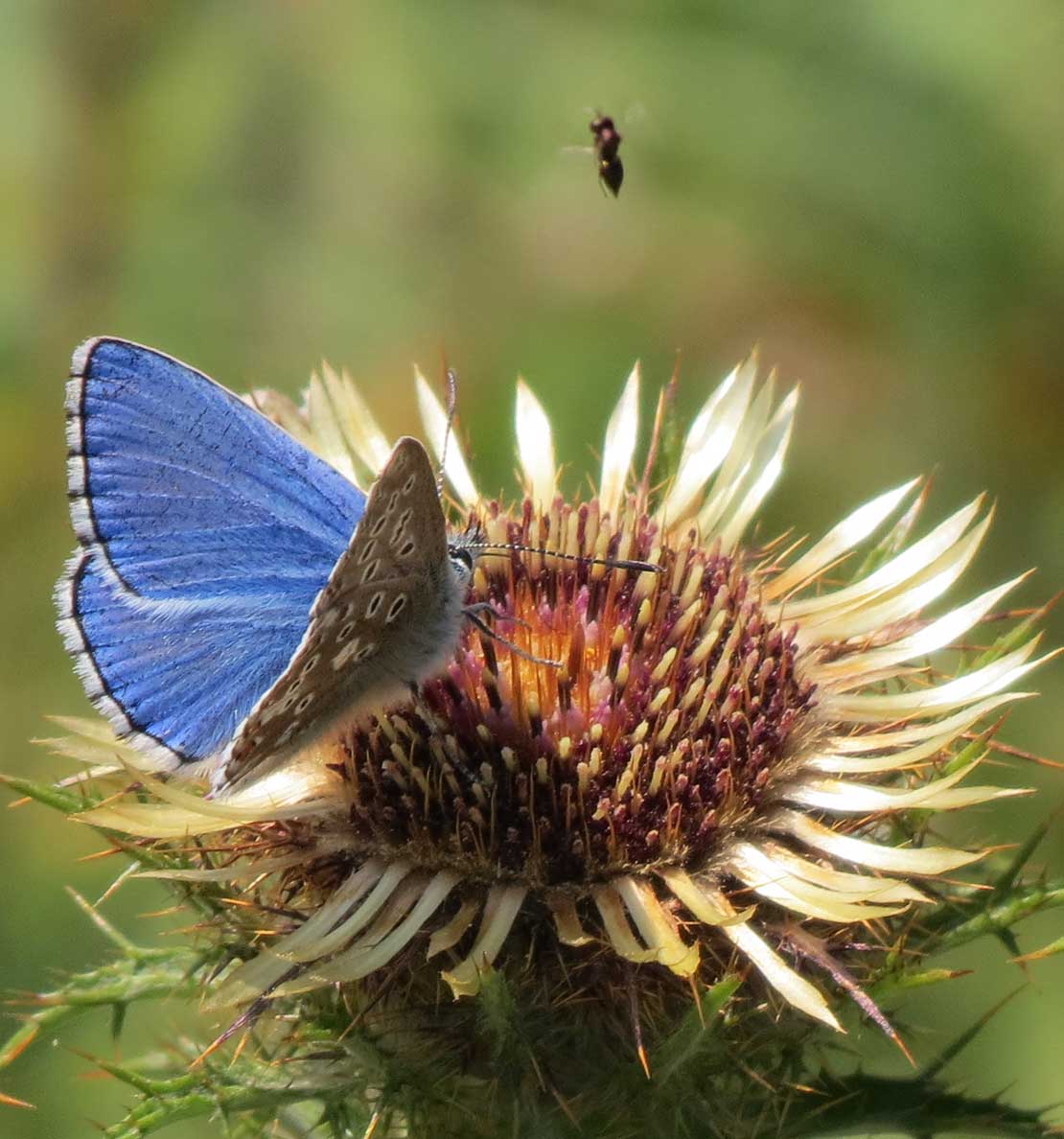 |
The small black fly is a Tanachid Fly. They are commonly referred to as íParasitic Fliesí because the larvae feed on the body tissues of immature or adult invertebrates. However, although we use the term parasite they are really parasitoids - the difference being that parasites (like tapeworms) donít kill their hosts, but parasitoids usually cause the death of the host in some way - either by killing them outright - or by weakening them so much that they die More Information Aplomya
confinis and Phryxe
vulgaris
are known to parasitise blue butterflies
as well as other species and moths.
|
27
August 2013
In
the low hundreds of white butterflies,
Large Whites and Small
Whites, by the coast but nothing special,
the only butterfly of note was a Painted
Lady on Lancing
Beach and a Small Tortoiseshell
on some Buddleia
between Old Shoreham and Ropetackle.
26
August 2013
An
impromptu journey through the Waterworks Road
to Mill Hill Cutting (SW) produced Large
White Butterflies (frequently seen everywhere)
a Red Admiral
and a dozen or so Common Blues.
Mill
Hill Cutting immediately produced half a dozen male Chalkhill
Blues in flight in a total of 12 males
seen in two minutes, and I disturbed simultaneously a surprising 13 female
Chalkhill
Blues in amongst the Horseshoe Vetch, Hippocrepis
comosa, leaves. The females
were all seen in an area of four square metres and
this is an unprecedented density locally for the females.
The Pixie Path on the west-east section (running parallel with the A27)
hosted three Wall Browns,
a few Speckled Woods,
a few Meadow
Browns and Holly
Blues.
 |
 |
 |
|
|
|
|
|
I ventured
to the lower slopes of Mill Hill which
was cast in shade from the few clouds on an otherwise sunny day. It was
late afternoon and most of the butterflies
were roosting, but they were easily disturbed in the short vegetation,
and clouds of butterflies, a dozen and more rose into the air in patches.
By far the most of them were Meadow
Browns, but there were plenty of Chalkhill
Blues,
Common
Blues
and
Adonis
Blues. It was not possible to count the
butterflies but in the one acre transect
I actually saw an estimated over two hundred Meadow
Browns
and each of the blues in region of forty, but many were hiding. There were
more female Chalkhill Blues
than the very tattered males. Other species seen were Large
Whites, a few Clouded
Yellows
(seven separate sightings but some may be duplicates), eight Wall
Browns (one on the upper part) a few Small
Heaths, a few
Gatekeepers and one Small
Tortoiseshell. A few pyralid
moths
were also seen.
Thirteen
butterfly species
 25
August 2013
25
August 2013
After
the rain, there were only small muddy puddles on
the Downs Link Cyclepath north of Old
Shoreham, where my first Southern Hawker,
(dragonfly)
of the year landed immediately in front of me on the clay path. The verges
were distinguished by thousands of Meadow
Grasshoppers instantly noted hopping about
in the vegetation. When the sun made brief
shine on an cloudy day, butterflies
appeared on the Buddleia
and amongst the verge flowers. Large
White Butterflies were the most noticeable
and frequently seen almost everywhere but there
were more than a handful of Green-veined
Whites definitely identified near the
Cement Works and occasional Small Whites
at the Shoreham end. Amongst the verge plants frequent
Common Blues were
seen from my bicycle but I if I walked amongst the tall verge plants many
more of both genders were disturbed. The brown
females were showing their alternate brown
blue appearance in flight and thus indicated Common
Blues. Close-up photographs of the underwing
confirmed they were not the very similar Brown
Argus.
Other
butterflies seen on the cyclepath and its Buddleia
were about ten Brimstones,
a few Peacock Butterflies,
a few Small Tortoiseshells,
Speckled
Woods in the shade, a few Holly
Blues, and only a few Meadow
Browns and Gatekeepers,
with one or two faded Painted Ladies.
On
Shoreham Beach Green I spotted a distant Clouded
Yellow.
Thirteen
butterfly species
23
August 2013
Warm
and humid and overcast and the summer weather has not broken yet. I
made a rather unusual trip on the outskirts
of Shoreham, the full length of the footpath surrounding Frampton's Field,
starting at the The Street entrance and ending at the top of Mill Hill
Road without crossing the bridge over the A27.
Large
Whites were the most widespread of the
butterflies
found in Shoreham town, but this route added
occasional
Holly Blues by the Ivy, a Red
Admiral basking on the wooden footpath
sign by the Butterfly Copse (juxta the Waterworks
Road), a Peacock
Butterfly on the Buddleia,
a few Meadow
Browns on and around the path, frequent
Common Blues on
the path and in Frampton's Field, a Small
Tortoiseshell with a bite out of its wing,
and a few Speckled Woods
at the top of the Pixie Path by the hedge.
 |
 |
|
Chalkhill Blues
At
the north-west corner of Frampton's Field it was possible to fight my way
through the Brambles on
the route of the old footpath to Mill Hill on to an area which I have names
Mill Hill Cutting (SW) where a Small White
Butterfly opened and then closed its wings.
In an area of about twenty square metres of bare chalk bank covered with
clumps of Horseshoe Vetch, Cotoneaster
and the leaves of Mouse-eared Hawkweed, there was a fabulous showing of
too many Chalkhill Blues
to
count accurately as I lost count at thirty, but estimated to be forty including
ten females (I
gave up counting these at seven) plus occasional Common
Blues
of
both genders to confuse the count. This count
extrapolates to 800 Chalkhill
Blues
per acre which is the maximum density expected in a good year (and not
seen on Mill Hill since 2003).
Most of the Chalkhill Blues
were rather worn and tattered with a few with just minor damage. The pairs
were courting and the females
were laying eggs. There were also frequent Silver
Y Moths.
Ten
butterfly species
22
August 2013
A
partly tattered Small Blue Butterfly
from Buckingham Cutting (south) was added to
the list of the previous
day, but despite having a close look at
the Common Blues,
I could not add a Brown Argus
to the list. They were all female Common Blues.
The list within the boundaries of Shoreham added Large
Whites, Small Whites, Meadow
Brown 1,
Gatekeeper 1, Holly
Blues, Speckled
Woods only.
 |
 |
 |
Silver
Y Moths were frequently seen in the undergrowth
on the edge of town.
Eight
butterfly species
21
August 2013
My
impression was he number of butterflies
were down from a week earlier, but there were still
sufficient numbers to be omnipresent and enough variety to be interesting.
There was also three or more times the density of butterflies on the lower
slopes of Mill Hill than on the on the
Lancing
Ring meadows.
The
butterfly species recorded were:
|
|
|
|
|
|
|
|
|
|
|
|
|
|
|
|
|
|
|
|
|
|
|
|
The numbers are for the whole of Mill Hill except for the blue butterflies. These are for the one acre transect area on the lower slopes of Mill Hill only for the Chalkhill Blues and Adonis Blues with a counted tally and the Common Blues with an estimate. All other substantial numbers were estimated, with single digit numbers counted..
*
Southern part of Mill Hill
~
Lower slope transect area only (numbers)
#
Upper car park Buddleia
bush only
 |
 |
 |
 |
|
|
|
|
|
There
were a handful more Chalkhill Blues
over the middle slopes,. The Holly Blue
was seen amongst the scrub. Common Blues
were frequently seen over the middle slopes and upper meadows of
Mill Hill. The transect estimate for Meadow
Browns
was about 130. There were frequent female Common
Blues and the photographs failed to discover
if any Brown Argus
were
there.
There
were more Large Whites
and Holly Blues
around Shoreham.
Mill
Hill Report
Brown
Argus & Female Common Blues ID chart
Eighteen
species (possibly nineteen but no positive ID)
I started and finished my tour of local sites at Mill Hill, where I hoped to photograph the second brood Adonis Blues. My brief morning visit was an instant success; only ten metres from the car park I found a beautiful female opening her wings wide to the morning sun for the very first time. When I returned in the evening the patches of longer grass and herbs along the lower slopes of Mill Hill were crammed with roosting butterflies. Large communal roosts of Adonis Blues, Chalkhill Blues and Common Blues were a joy to sift through in the calm conditions. The biggest and most welcome surprise of the day came just as I started to descend the steep scree slope at Mill Hill. At 6.10 pm most of the butterflies were already at roost ... but not the Silver-spotted Skipper which landed at my feet! County Recorder Colin Pratt can find no historic records of the species here, and it has certainly been absent since at least the 1930s. I was delighted, as this is the third new site for Silver-spotted Skipper I've found in the last few weeks.
All three species of white butterflies were seen on a coastal cycle trip to Worthing; by far the most were the Large Whites around the Sea Kale followed by Small Whites with at least a few Green-veined Whites, at least two surprise Speckled Woods and a handful of Red Admirals.
 |
|
 |
|
|
|
|
I made
a rare visit to Lancing Ring Nature Reserve
where there were more white butterflies,
Speckled
Woods in the shade and over a hundred butterfliesin
the meadows. By far the most numerous of the meadow butterflies were over
fifty Common Blues
seen
amongst the tall vegetation, almost all of them males, frequent Meadow
Browns
and
frequent Gatekeepers. Wall
Browns (25+) were all over the well used
paths with a few in the meadows where three male Chalkhill
Blues fluttered in the sunshine in the
south-west corner. There was at least one Red
Admiral noted by the dewpond
puddle and Silver Y Moths around.
Overall, I must have seen in excess of a hundred Large
Whites which were the butterflies seen mostly
around the Buddleia.
I originally accepted the presence of the Brown
Argus
but the few photographs in focus turned out to be female Common
Blues.
I
had to wait until I got to Old Shoreham before I saw a Small
Tortoiseshell on a Buddleia.
I saw a few Holly Blues
in Lancing.
Twelve
species
19
August 2013
Mill
Hill under a cloudy sky
and many of the butterflies
on the lower slopes were hiding and their numbers were less than could
be expected when sunny.
This was especially true of the 50+ Adonis
Blues and
sometimes I had to almost tread on them to see them in flight. Both Chalkhill
Blues
and
Meadow
Browns
were
in excess of fifty as well as I started counting them but then guessed
the numbers as I did not cover the full acre
transect as normal. Females were only 8% of
the Chalkhill Blues
and one fresh specimen was suspected of being a female Adonis
Blue but it is almost impossible to separate
the females of the two species by appearance. Common
Blues
were
around the fifty mark on the lower slopes but Gatekeepers
were
slightly less, estimated at just under fifty.
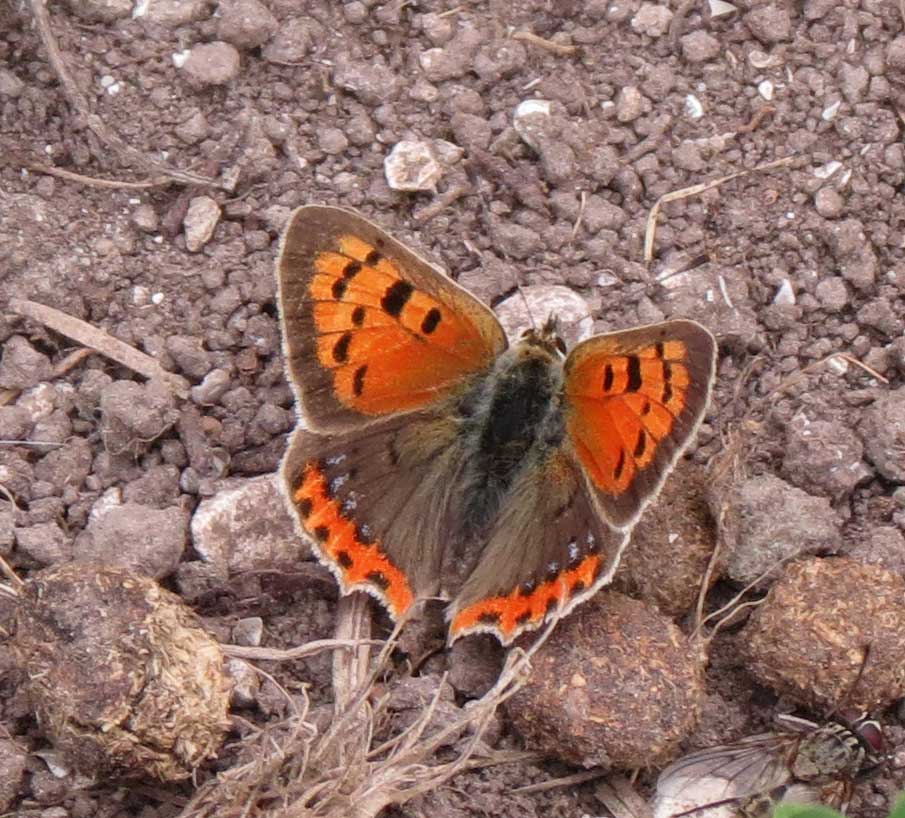 |
 |
 |
|
|
|
|
Other
butterflies seen were at least two Wall
Browns amongst the longer Tor Grass, a
handful of Small Heaths
only when the sun came up briefly, one Peacock,
four lively Clouded Yellows,
occasional Large Whites,
at least one Small White,
and my first Small Copper
of the year. A few Speckled Woods
were seen by the southern steps. Treble-bar
Moths were disturbed and these were not
so lively. One faded pyralid
micro-moth
Pyrausta nigrata was spotted but I
expect many more were in hiding in the early afternoon.
At
the top of the hill by the hedge just north of the bridge, two Holly
Blues fluttered around.
Two
Red
Admirals sparred over Shoreham-by-Sea
railway crossing.
Fifteen
butterfly species and one macro-moth
Adur
Butterfly Flight Times
18
August 2013
A
cursory look on the Downs Link Cyclepath
Buddleia in the rain
and there were Large Whites
fluttering around but the only other butterflies
were a single each of a Painted Lady
(in the same area as three
days ago) and a fresh looking Gatekeeper.
 |
17
August 2013
Garden Tiger Moth seen in a Lancing garden. Adur Moths |
15
August 2013
Large
Whites, Green-veined Whites and
Small Whites, were very easily seen on
the Buddleia
bordering the Downs Links Cyclepath from
Old Shoreham to the Cement Works and back. All the other butterflies
had to be looked for in the afternoon sunshine and the Buddleia
proved
attractive to the vanessids:
occasionally seen Comma,
Peacock,
Small
Tortoiseshell,
Red Admiral and one Painted
Lady. Brimstone
Butterflies (not
seen the previous day)
visited the purple flowers of the Butterfly
Bush. Gatekeepers,
Meadow
Browns
and
Common Blues.
were seen in the meadow-like verges.
 |
 |
 |
 |
|
|
|
|
|
A few
Holly
Blues fluttered around the bushes and
a half a dozen Speckled Woods congregated
in the shade. Buddleia
proved the most attractive for butterflies and the abundant Fleabane
their second favourite. The total count of white
butterflies was over a hundred in an hour
and the cumulative count of the other butterflies seen was about sixty.
Fourteen
species
14
August 2013
Fourteen
species of butterfly
were seen under
the overcast sky, blown about in the breeze,
and all before I reached Mill Hill, when
four
more were added making an impressive total of eighteen on a day that was
so humid that I twice got caught in brief and warm rain showers.
Flying in off the sea, a faded Painted
Lady was seen on the cyclepath east of
Worthing Pier, and a Clouded Yellow
on the beach by Brooklands, east Worthing. I walked Path
3138 through the Waterworks Road
and up the Pixie Path recording in order
of first seen: Large White, Green-veined
White, Small White, Holly
Blue,Speckled
Wood, Comma,
Peacock,
Small
Tortoiseshell, and Gatekeeper,
all seen in a few minutes at the bottom of the path around the Butterfly
Copse with its Buddleia
and Stinging Nettles. Mill Hill Cutting (south) added about fifteen Chalkhill
Blues
and
Frampton's Field occasional Meadow
Browns
and
Common Blues.
Under
the rain laden sky the southern top part of
Mill Hill hosted frequent Gatekeepers,
Meadow
Browns,
Common
Blues
and
my first Wall Brown of
the early afternoon. On the southern steps my second Clouded
Yellow of the day was quickly seen with a
few Speckled Woods.
The
rain seemed so imminent that I did not walk
the
transect
and count the butterflies but just made notes in passing over the lower
slopes. Estimated numbers of Meadow Browns
was
at 150 an acre, Gatekeepers and
Chalkhill
Blues
just under a hundred an acre and Common Blues
well
over fifty. Small Heaths
were occasionally spotted and I was surprised to seen a slightly damaged
Marbled
White. There was a few Large
Whites, a Small
White, a Peacock
Butterfly, a Small
Tortoiseshell at least two male Adonis
Blues as it briefly
started to rain. If there was just the one
Clouded
Yellow it flew the whole length of the lower
slopes, where at the northern end a Silver
Y Moth fluttered onto some Wild Privet.
The Chalkhill
Blues
were
mostly worn and in poor condition with just an estimated 15% of the males
looking fresh and bright.
 |
 |
 |
 |
|
|
|
|
|
I made
a change from my normal route through Mill Hill
Nature Reserve and did not climb up the steps through the scrub as
the paths were too overgrown. Instead I trekked an easier passage (a more
gradual gradient) to the middle slopes from the south. The Buddleia
tree in the middle of the scrub hosted at least five Peacock
Butterflies easily seen and a not so easy
to spot Red Admiral.
One
Marjoram
clump on the middle slopes hosted three Small
Tortoiseshells and there were Gatekeepers
everywhere and frequent Common Blues
and
occasional Chalkhill Blues.
When
I arrived home at 4:00 pm,
there was a Holly Blue
fluttering around my Garden Privet.
Eighteen
butterfly species and one macro-moth
13
August 2013
Breezy
and overcast so the butterflies
were resting in the afternoon on the lower slopes of Mill
Hill. About twenty of the Chalkhill
Blues were hiding. Meadow
Browns
were everywhere though and over a hundred were spotted with frequent Gatekeepers
and occasional Small Heaths,
three Wall Browns
and at least two Common Blues.
There was also the unexpected sight of a possible Silver-spotted
Skipper which would be a first for Mill
Hill.
By
the Ham Road allotments over Eastern Avenue there were scores of Large
Whites and I saw Speckled
Woods and one Painted
Lady on my travels.
Nine
butterfly species (possibly ten)
9
August 2013
 Too
breezy and overcast to visit the downs,
I
did venture to the top of The Drive where there were a few Speckled
Woods, and to Buckingham
Cutting (south) where there was Common
Blue but no Small
Blues in the early evening when butterflies
should be roosting. Green-veined Whites
and both Large Whites
and Small Whites
were identified and a Red Admiral
fluttered over. A Silver Y Moth flew
out of the meadow vegetation. A few Holly
Blues fluttered over the scrub/hedgerow,
and I disturbed a few Meadow Browns,
but
no Ringlets,
on the meadow-like road verges opposite Slonk Hill.
Too
breezy and overcast to visit the downs,
I
did venture to the top of The Drive where there were a few Speckled
Woods, and to Buckingham
Cutting (south) where there was Common
Blue but no Small
Blues in the early evening when butterflies
should be roosting. Green-veined Whites
and both Large Whites
and Small Whites
were identified and a Red Admiral
fluttered over. A Silver Y Moth flew
out of the meadow vegetation. A few Holly
Blues fluttered over the scrub/hedgerow,
and I disturbed a few Meadow Browns,
but
no Ringlets,
on the meadow-like road verges opposite Slonk Hill.
Eight
butterfly species
8
August 2013
Hundreds
of butterflies
fluttered around the parched lower slopes of Mill
Hill in an average year (but still less than a third of a tally in
a good year). Chalkhill Blues
were out in force with over two hundred seen. The
one acre transect count was 131 (with an estimated 15 females). Both
Gatekeepers
and Meadow Browns
were everywhere with estimated numbers at about a hundred an acre for each.
Common
Blues
were very noticeable with at least thirty seen mostly around the longer
Tor Grass in the central part. Marbled
Whites were still in flight which was
a bit late for them. About ten were seen including two that seemed smaller
than normal. There were some Large Whites
that looked the size of Brimstones.
The latter were not seen on the lower slopes. Both Green-veined
Whites and Small
Whites were also identified. Small
Heaths had increased in number with fifteen
or more. Speckled Woods
were seen in the shady places around the southern steps and in the scrub
at the northern end.
 |
 |
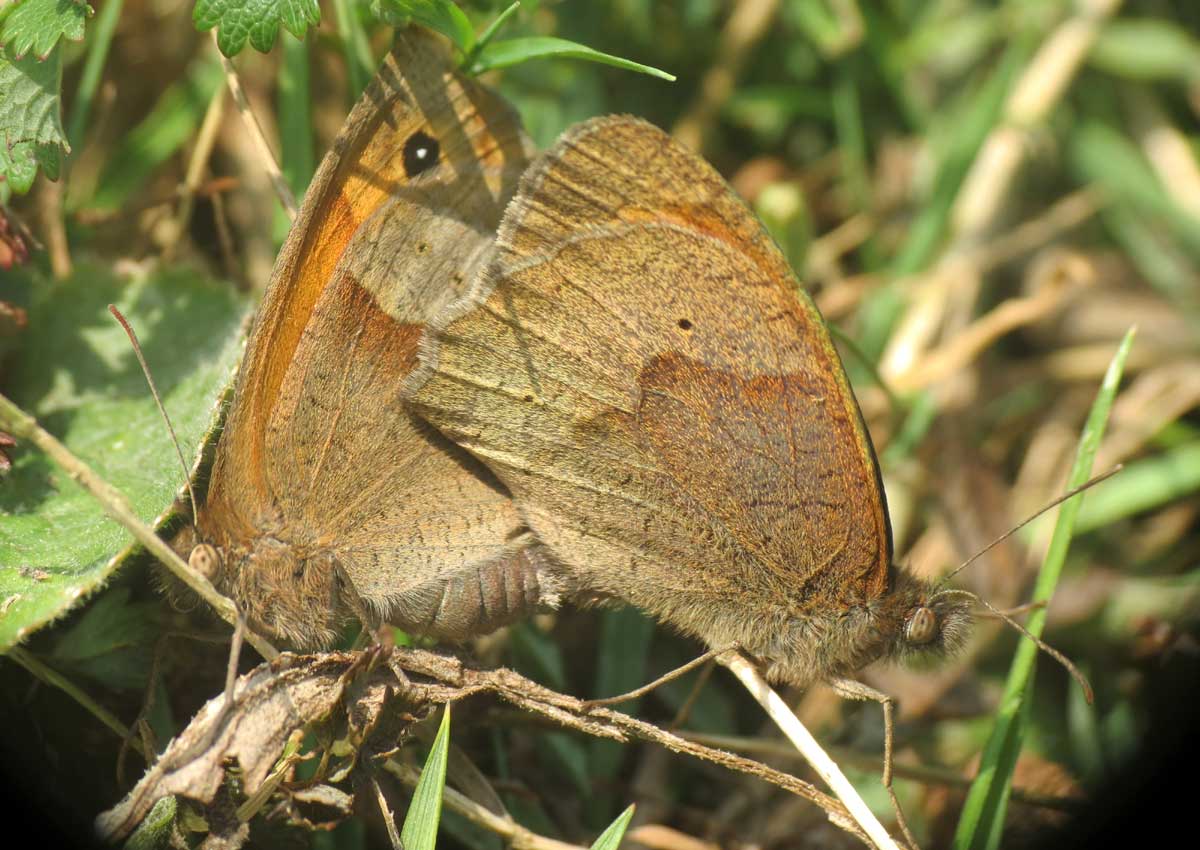 |
|
|
|
|
A bright
Painted
Lady landed on a Stemless
Thistle. A Peacock
Butterfly was a colourful addition over
the slopes. But
the highlight of the day was a Dark Green
Fritillary restlessly patrolling over
the lower slopes by the bottom wayward hedge at about 12 mph. It landed
just once for a second on a Hardhead.
(The
photograph was out of focus.) I went back
to try a decent photograph and suddenly there was a flash of bright yellow
in the sunshine from my second Clouded
Yellow of the year. It ended up chasing
the Dark Green Fritillary
before it fluttered away rapidly. Butterflies were courting and three species
were seen in mating sequences: Common Blues,
Meadow
Browns
and
Chalkhill
Blues.
At first I did not notice the brown female Chalkhill
Blues but after I retraced my steps many more
of mostly plain brown specimens were seen, as many as thirty five with
one pair courting and another in copulation. It was then I had a closer
look at the Common Blues
and I found a handful of the larger male second brood Adonis
Blues. The brown ones with orange wing
fringe spots were almost certainly female Common
Blues
rather than a few Brown Argus.
Moths
made occasional appearances; the inevitable
Six-spotted
Burnet Moths, occasional Silver
Y Moths, at least one Treble-bar
Moth and a faded pyralid
moth Pyrausta nigrata.
A Hornet Robber Fly
settled on the winding path.
The
top of the Pixie Path (the only part visited)
hosted Speckled Woods,
and Common Blues
and
Holly
Blues sparring with each other. A Red
Admiral was seen in Western Road, Shoreham
town.
Seventeen
butterfly species (three new species) and three macro moths
Chalkhill Blues
7
August 2013
On
a cloudy day nine species of butterfly were
seen on the outskirts
of Shoreham including a Holly Blue
and a Wall Brown
not seen on the previous day.
 |
|
 |
|||
|
|
|
|
I fought
my way though the Brambles to the north-facing southern bank of the A27
verge which is Mill Hill Cutting (SW). Despite being overcast eight male
Chalkhill
Blues were seen immediately flying simultaneously.
As conditions were good for photography, I stayed around in this garden-sized
area and at one time I estimated fairly accurately that their were thirty
males
and two female Chalkhill Blues.
The males did
not seem to be chasing the females as much as quarrelling with each other.
A
Painted
Lady was seen by Middle Road allotments
on the path than runs along the western fence.
Pixie
Path & Mill Hill Cutting Report
Chalkhill
Blues Notes
Ten
butterfly species
6
August 2013
After
the heavy rain of the previous day, I went
straight to Mill Hill around midday.
Even
before I left Corbyn Crescent, I recorded a Meadow
Brown,
Red
Admiral
and
Large
White simultaneously in the twitten
to Adelaide Square. On the roads to Mill Hill there were more Large
Whites and a few Small
Whites. Under the shade of the trees/bushes
at the top of Chanctonbury Drive on the north side there were at least
two Speckled Woods.
On
the southern part of Mill Hill, I noted scores of butterflies
mostly Meadow Browns
in
excess of thirty, occasional Gatekeepers,
Small
Whites and Large
Whites with a Peacock,
Chalkhill
Blue, a Small
Skipper and another Speckled
Wood all within a few minutes.
 |
 |
 |
|
|
|
|
The
object of the trip was to record the number of Chalkhill
Blues in the
one
acre transect of the lower slopes. The tally
was 115 (108 males
and 7 females).
Most of the transect walk was in the shade
of a cloud, but when the sun came out, more
of these blue butterflies appeared. The newly budding and flowering
Carline Thistle was attractive to bees
and butterflies. The other numbers were partly counts and estimates in
the male Common Blues
at 35+, or total estimates of the Meadow Browns
at
230+ or double the number of Chalkhill Blues.
Other counts were Small Heaths
(5+), one tattered yellow Brimstone,
seven Marbled Whites
(some sightings deducted to avoid duplicates), at least a dozen Large
Whites, an estimated twenty or more Gatekeepers,
two Treble-bar Moths
and at least one Six-spotted Burnet Moth.
Walking
through the scrub on MIll Hill, there were Gatekeepers
and Meadow Browns
everywhere. I even managed to spot a Ringlet
by the gate to the Old Erringham pasture. On a large Buddleia
surrounded by Stinging Nettles and Brambles on the overgrown middle slopes,
there was score or more of butterflies, at least a dozen Red
Admirals, four or more large Peacocks,
one small Comma
and the inevitable Meadow Browns
and
Large
Whites.
 |
 |
 |
|
|
|
|
When
the scrub opened out to the open glade on the middle slopes Marjoram
was flowing abundantly and attracted butterflies on most of the clumps,
Meadow
Browns,
Gatekeepers, Peacocks
(three on one clump), Painted Ladies
(two on the same clump and one on another) and the first of a few Green-veined
Whites and some of the 19 Chalkhill
Blues. The half a dozen or so
Common Blues did not seem to be particularly
attracted to Marjoram
like the other butterflies, and all of the nine Brimstone
Butterflies fluttered rapidly between one
Wild
Basil flower and another.
Finally
over the top of Mill Hill, Gatekeepers
predominated with frequent Meadow Browns,
three male Chalkhill Blues,
one Small Skipper,
a few Large Whites,
at least one each of Painted Lady and
Peacock,
a few
Six-spotted Burnet Moths and
frequent Silver
Y Moths.
Sixteen
butterfly species and three macro-moths
4
August 2013
In
the morning a Speckled Wood Butterfly
visited by semi-wild garden in Corbyn Crescent, Shoreham. It stayed for
a few minutes settling on a Garden Privet leaf. Down by the estuary
the cyclepath in Old Shoreham were lined with purple Buddleia.
It is aptly named the Butterfly
Bush as it proved an attractive
nectar source for a dozen or more vanessid
butterflies seen on a couple of bushes next to the River
Adur on a high neap tide.
 |
 |
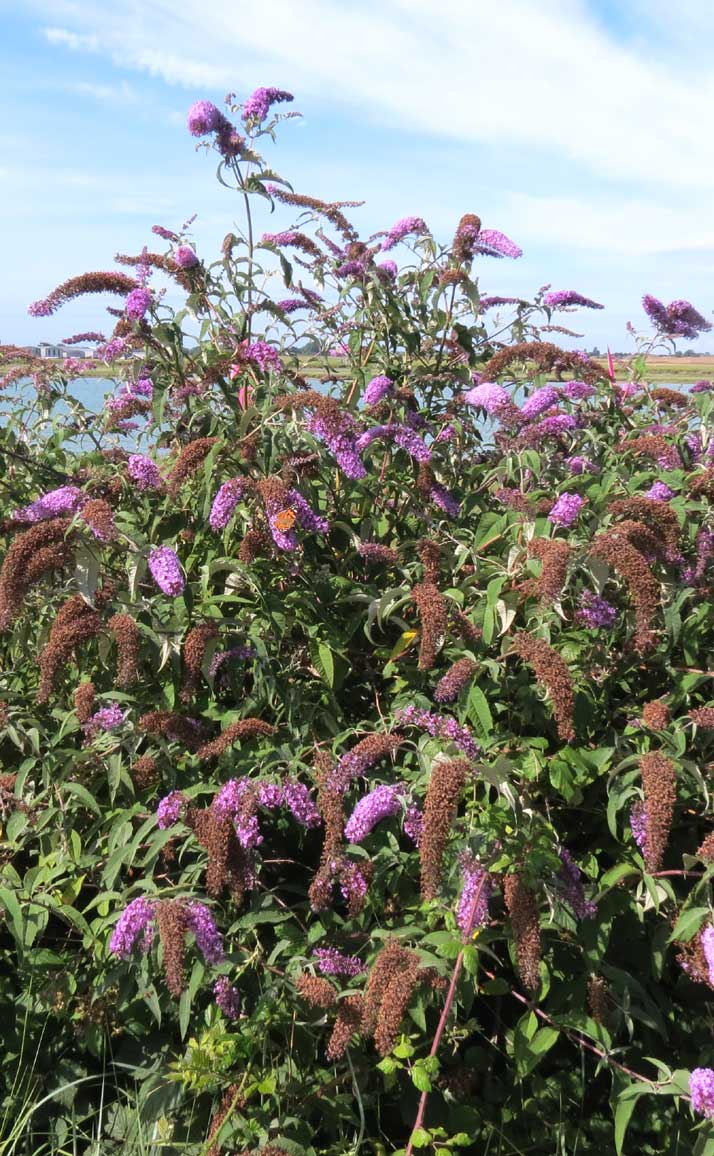 |
 |
Painted Lady
It
seems there has been recent influx of the immigrant Painted
Lady as the first seen and the most prevalent
butterfly
and found exclusively feeding on the Buddleia.
It was accompanied by a few Red Admirals
and at least one Peacock Butterfly.
Nearby there were Green-veined Whites,
Large Whites, Meadow
Browns
and
Gatekeepers
in
order of frequency. Later on in the afternoon, the Buddleia
by the houseboats on the Riverbank attracted more Red
Admirals, Peacock
Butterflies, Large Whites
and at least one Painted Lady.
Small
White Butterflies were seen in Shoreham
town.
Nine
butterfly species
2
August 2013
Flowering
Buddleia adorned the hedgerows bordering
both side of the cyclepath from Ropetackle to Upper Beeding (Dacre Gardens)
and this proved to be an attraction to scores of Red
Admirals (25+ actually seen). Most of
the usual butterflies
were fluttering around the verges. The most numerous were the Green-veined
Whites (25+) but there were frequent
Meadow
Browns,
Gatekeepers, Common Blues,
and Large Whites,
with occasional Peacocks
and
Comma,
and a few Speckled Woods and
at least one Small Skipper. A
Silver
Y Moth was disturbed on the cyclepath
verges. At Anchor Bottom I discovered
that all the Ragwort
and Creeping Thistle
on the bottom part had been mown, so I only stayed a few minutes, enough
to see a few male Common Blues
and after a few minutes a few Chalkhill
Blues on the north-facing southern slopes.
I disturbed a Small Tortoiseshell
before I left.
A
Small
White was seen in Shoreham town.
Thirteen
butterfly species
1
August 2013
I
took a direct route to Mill Hill (through
Buckingham Park and Buckingham Cutting
(south) and the Dovecote Estate) with an object just to count the Chalkhill
Blue Butterflies which it previous years
had peaked at the turn of the month. In the one
acre transect I counted eighty
blue males that were very lively in the humid
warm sunshine and there were many more all over the slopes. However, I
did not spot even one of the brown females
and I surmise that these blue butterflies have not peaked in numbers yet.
The relative dearth of Chalkhill Blues
was made up by my first ever definite Dark
Green Fritillary in Shoreham, flying very
strongly over the southern part of Mill Hill, over the Ragwort
without settling. (It was only recognised as a fritillary
and Dark Green
is most probable because of the downs habitat.) Shortly afterwards, I nearly
walked into a good condition bright Painted
Lady. It had settled on a Ragwort
until I got my camera out. Sixteen of the
twenty species of butterfly
seen on the day were seen on Mill Hill. Butterflies were common, with hundreds
on the downs and far too many to count.
The
Small
Blue was seen on Buckingham Cutting (south). After leaving
Mill
Hill I went out of way just a little to increase
the species tally: the Comma
was seen in the Butterfly Copse by the Waterworks Road, the confirmed Green-veined
White on the path (linear copse) than
runs alongside the A27
opposite Slonk Hill through the trees, and lastly the Ringlet
on
the road verge opposite Slonk Hill.
It
was the first record of a Ringlet Butterfly
in the month of August.
Adur
Butterfly Flight Times
 |
 |
 |
 |
|
|
|
|
|
| Butterflies | Outskirts | Mill Hill lower | Mill Hill scrub and upper |
| Large White | 12+ | 5+ | 3+ |
| Small White | 7+ | - | - |
| Comma | 2 | - | - |
| Gatekeeper | 50+ | 50+ | 50+ |
| Speckled Wood | 35+ | - | 8+ |
| Meadow Brown | 12+ | 30+ | 10 + |
| Red Admiral | 4 | - | 2+ |
| Holly Blue | 14+ | - | - |
| Small Skipper | 12+ | 5+ | 4+ |
| Marbled White | 10+ | 12+ | 4+ |
| Dark Green Fritillary | - | - | 1 |
| Peacock | 3 | 8 | 2 |
| Small Tortoiseshell | 1 | - | 2 |
| Brimstone Butterfly | - | 2 | 1 |
| Chalkhill Blue | - | 80+ | 10+ |
| Painted Lady | - | - | 1 |
| Common Blue | 5+ | 2 | 5+ |
| Green-veined White | 1+ | - | ? |
| Small Blue | 1 | - | - |
| Ringlet | 1 | - | - |
| Silver Y Moth | 10+ | - | 7+ |
| Six-spotted Burnet Moth | 12+ | 12+ | 35+ |
These
totals were the butterflies actually seen and the double digit numbers
were half counted and estimated except for the one acre count of the Chalkhill
Blues. Gatekeepers
were heavily understated as they were hiding everywhere in the hedgerows
and scrub. But these understating of numbers applied to the Speckled
Woods and almost all the others.
NB:
I did not visit Mill Hill Cutting (SW) on the day.
Twenty species of butterfly and two macro-moths (highest butterfly species total this year and the second highest ever)
I completed my Mill Hill transect in the morning with the following results: Brimstone 4, Chalkhill Blue 110, Common Blue 2, Gatekeeper 16, Green-veined White 1, Large White 2, Marbled White 2, Meadow Brown 138, Peacock 11, Red Admiral 3, Small Copper 1, Small Heath 1, Small Skipper 1, Small White 1, Wall 1, misc. whites 9, also Silver Y 5. Chalkhill Blues, Meadow Browns and Peacocks have increased since last week, and this was the first second brood Wall on Mill Hill.
27
July 2013
Hundreds
of butterflies
fluttered over the lower slopes of Mill Hill
around midday.
It
was warm when the sun came out from behind the wispy clouds with hardly
a breeze and this encouraged the butterflies
of mainly four species with 78 Chalkhill
Blues (76
males and 2 females) counted in one acre of
the transect, with estimated counts of 60
Gatekeepers,
75 Meadow Browns,
and 25 Marbled Whites,
plus 15 Large Whites,
two Red Admirals,
one Peacock
and
a bright yellow Brimstone Butterfly.
Six-spotted
Burnet Moths were frequently seen. I returned
by the winding path route and as the sun and warmth became greater there
were even more butterflies* all over the five acres of the lower slopes
in about even distribution, with more on the upper part of the hill. The
Marbled
Whites were especially prevalent with another
25 seen around the winding path. Two tiny pyralid
moths
were spotted: Pyrausta nigrata and
the colourful Pyrausta purpuralis.
(* Estimated 350+ Chalkhill Blues
on the total area of the lower slopes).
Small
Skippers were frequently seen but it seemed
that most of them were on the southern part of Mill Hill at the top amongst
the Ragwort and
Teasels.
On the southern part there were the inevitable Gatekeepers
and Meadow Browns,
as well as a Comma Butterfly,
a few Chalkhill
Blues, and more Marbled
Whites and a brightly coloured Painted
Lady.
 |
|
 |
 |
|
|
|
|
|
I travelled
to Mill Hill via the Pixie Path and the butterflies
seen here were Speckled Woods,
the inevitable Gatekeepers
and Meadow Browns,
Marbled
Whites,
Small
Skippers, two Holly
Blues, a Red
Admiral and occasional Large
Whites. A dozen
male Chalkhill
Blues appeared on Mill Hill Cutting (south)
before I reached Mill Hill.
Thirteen
butterfly species (no new species not seen before this week)
26
July 2013
No
new butterfly
species could be added to list of the previous two days,
although the usual ones were present of a cycle trip to Cuckoo's
Corner along the towpath and back along the Coombes Road: frequent
Gatekeepers,
Large
Whites, Small Whites, occasional Meadow
Browns,
Small (or Essex) Skippers, a few each
of Comma Butterflies, Speckled
Woods, Red Admiral,
and one Peacock Butterfly and
one Marbled White.
Ten
butterfly species
25
July 2013
In
the afternoon the clouds cleared so I did my Mill
Hill butterfly transect with the following
result: Chalkhill Blue
63, Comma
1, Dark Green Fritillary
1, Gatekeeper
60, Green-veined White
1, Large White
1, Marbled White
16, Meadow Brown
116, Red Admiral,
Small
Heath 1, Small
White 2, other Whites
8.
Gatekeepers
and Chalkhill Blues
continue to increase, but the big news was the Dark
Green Fritillary which is the first I have
recorded on Mill Hill.
It settled a couple of times, then flew off strongly and left the area.
Eleven
butterfly species

A half an hour passage trip along the southern bank of the A27 opposite Slonk Hill, resulted in three species of butterfly not recorded on the day before. I only spent about ten minutes looking for butterflies but it was enough to spot a Small Blue Butterfly immediately on Buckingham Cutting (south) as well as a Cinnabar Moth, two Large Skippers on the edges of the linear copse in an open area and lastly a Ringlet on the top part of the roadside verge at the eastern end. Other butterflies seen on the brief trip included MeadowBrowns, Gatekeepers, Speckled Browns, one Holly Blue, one Comma, Large Whites, Small Whites and at least one Marbled White. A few Yellow Shell Moths were seen. Six-spotted Burnet Moths were occasionally seen as well as a few unidentified micro-moths. I was also fortunate enough to spot the first of the large hoverflies of the year. It was the attractive Volucella inanis.
Adur Skippers
Adur Burnet Moths
Eleven butterfly species and two macro-moths
 |
 |
 |
 |
|
Chalkhill
|
Blue |
|
|
| Butterflies | Approaches to Mill Hill | Mill Hill lower | Mill Hill scrub and upper |
| Large White | 5+ | 5+ | 3+ |
| Small White | 3 | - | - |
| Comma | 4 | 1 | 1 |
| Gatekeeper | 12+ | 18+ | 10+ |
| Speckled Wood | 2 | - | 3 |
| Meadow Brown | 8+ | 16+ | 5+ |
| Red Admiral | 4 | 1 | - |
| Holly Blue | 1 | - | - |
| Small Skipper | 3+ | 1+ | 5+ |
| Marbled White | 3 | 5 | 3 |
| Small Heath | 1 | - | - |
| Peacock | 1 | 2 | 2 |
| Small Tortoiseshell | 1 | - | 1 |
| Brimstone Butterfly | - | 2 | 1 |
| Chalkhill Blue | - | 28 | 2 |
| Painted Lady | - | - | 1 |
| Yellow Shell Moth | 2 | - | - |
| Six-spotted Burnet Moth | - | 5+ | 50+ |
| Silver Y Moth | - | - | 3+ |
I was
not an avid butterfly counter on the day and there may be many more butterflies
I missed.
Sixteen
butterfly species (the most in a day this year) and three macro-moths
21
July 2013
A
short trip to the Adur Flyover and Boot Sale and back via the Downs Link
Cyclepath recorded one Small Heath,
occasionalSmall (or Essex) Skippers,
a few Gatekeepers,
occasional Meadow Browns,
occasional Large Whites,
two Small Whites,
at least one Marbled White,
and a few Narrow-bordered Five-spot Burnet
Moths. Later a Small
Tortoiseshell was seen next to Middle
Road allotments.
Eight
butterfly species and one macro-moth
19
July 2013
Warm
early on in the morning (9:00 am)
I again left it late (11:00 am)
to take Footpath 3138
to Mill Hill, fighting my way through the
Brambles at the Maple Copse entrance from the Steyning Road (at Old Shoreham)
where a Small (or Essex) Skipper,
a Red Admiral,
a Gatekeeper and
Large
White made a simultaneous appearance.
Such was the difficulty getting through it was two minutes before I made
it to the Waterworks Road
section of the footpath where a probable
Green-veined
White was recorded. A few minutes later
the bright orange of at least one Comma
Butterfly flashed by with another Red
Admiral over the Pixie
Path (by the steps from the Waterworks Road). The Pixie Path hosted
occasional Small Skippers
(5+), occasional Meadow Browns
(3+),
three Marbled Whites,
and more Large Whites
and Gatekeepers
(7+).
A Comma seen
on the hedges on the side of Mill Hill road north of the bridge. By
the time I reached Mill Hill I was suffering from fatigue in temperatures
of 25.9 °C at
midday.
I
only ventured down to the southern part of the lower slopes where Marbled
Whites and male Chalkhill
Blues were in the same numbers and with
the same restlessness as my previous visit two
days ago. There were frequent Gatekeepers,
occasional Small Skippers,
Meadow
Browns
and
Large
Whites, two Small
Whites and at least one Small Heath
and about ten Six-spotted Burnet Moths
in flight. Surprisingly, no Small Tortoiseshells
were discovered.
Ten
species of butterfly and one day-flying moth
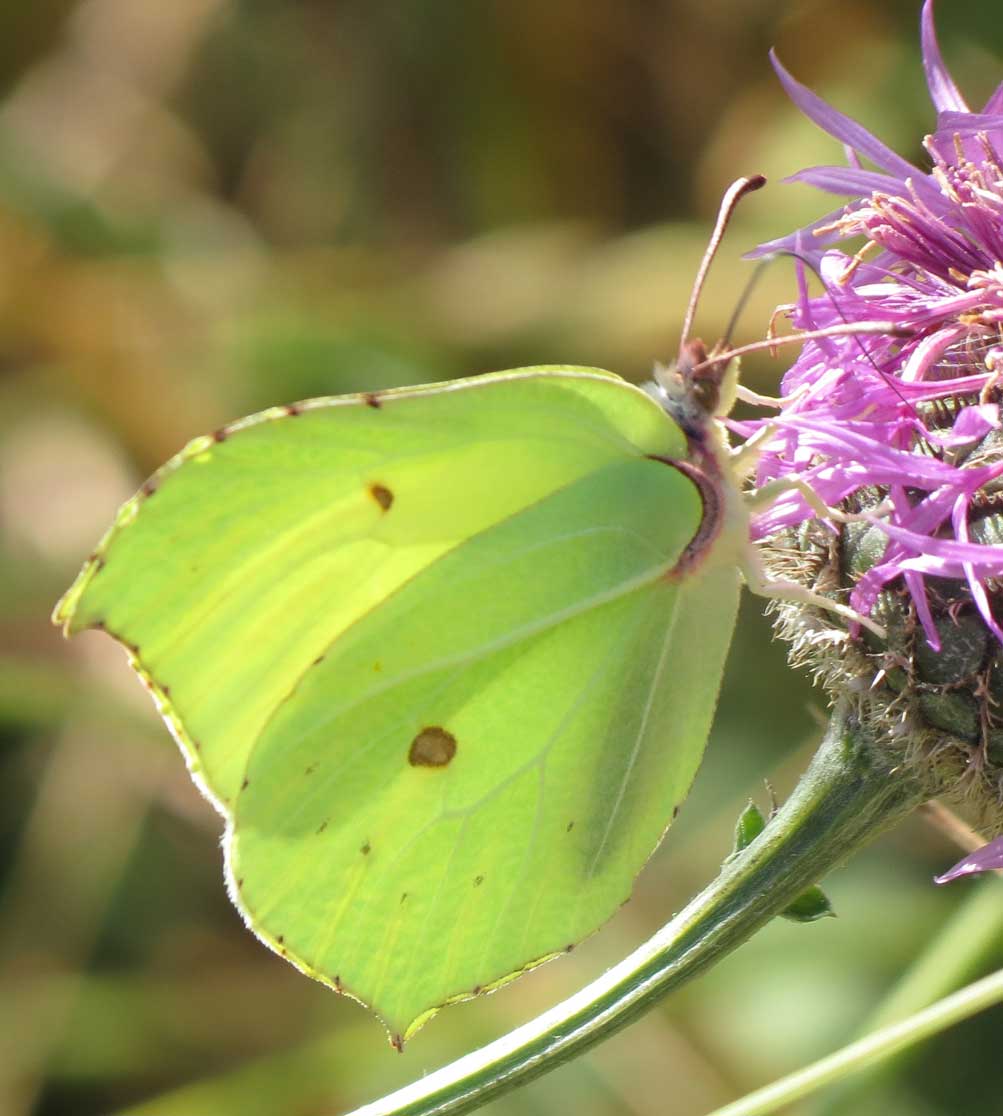 17
July 2013
17
July 2013
A
Small
White Butterfly was seen in Shoreham town.
On
the southern upper part of Mill Hill, butterflies
appeared in under a minute, firstly a Meadow
Brown,
followed immediately by a Small Skipper
amongst
the long grasses, and a Small Tortoiseshell
amongst the prevalent Ragwort.
The Ragwort also
hosted a Cinnabar Moth but
I did not see any caterpillars.
The meadows were full of Greater Knapweed
now in flower.
Amongst the dense meadows I disturbed a Silver
Y Moth and watched about ten Six-spotted
Burnet Moths in flight.
At
last I spotted my first Chalkhill Blues
on the lower slopes of Mill Hill with 14 of the blue males counted in the
one
acre transect in the heat of the middle of
the day. All these new butterflies
were restless and none of them settled even for a second. The same restlessness
applied to the Marbled Whites
with 39 counted on Mill Hill (37 on the lower slopes). Gatekeepers
(35+) were frequently seen amongst the scrub (including the hedgerow at
the bottom of the lower slopes), two bright orange Comma
Butterflies, two Speckled
Woods, and a few Large
Whites. A bright yellow Brimstone
Butterfly skirted the hedgerow at the
bottom of the lower slopes. I registered about five Small
Heaths on the open slopes with frequent
Meadow
Browns
(15+).
I returned by the quickest ridge route where the Speckled
Woods and most of the Gatekeeperswere
seen. There was another Small Tortoiseshell
by the Reservoir.
Twelve
species of butterfly and three day-flying moths
16
July 2013
A
passage trip to Worthing and back saw occasional Large
Whites on the Sea
Kale by Widewater,
a Small White
in Ray
Hamblett's south Lancing garden and a
Ringlet
on the Airport road by Ricardo. Buddleia was
flowering
in Old Shoreham on the verges of the cyclepath but no butterflies
were seen on these bushes. A Garden Tiger
Moth caterpillar was seen in my small
front garden in Corbyn Crescent, Shoreham.
 15
July 2013
15
July 2013
In
the late afternoon sunshine, I made a quick
detour to Buckingham Cutting (south) where
in under a minute the first of about ten Small
Blue Butterflies appeared on the small
wild flower rich meadow. There may have
been many more of these tiny butterflies which were dwarfed by the arrival
of three Marbled Whites. These
Marbled Whites very rarely settled, but I spent some time chasing them
vainly for decent photograph. During this time a Ringlet
and a Meadow Brown
appeared.
I could have spent more team amongst the meadow amongst the Kidney
Vetch, Lady's Bedstraw, Cleavers,
Pyramidal
Orchids, Greater Knapweed,
Ox-eye
Daisies,
Restharrow
etc., if wasn't for the noise of the relentless traffic on the A27.
A Burnet Moth
flew over the flower tops. Amongst the Brambles, the first of two Gatekeepers
were positively seen along with a Red Admiral
and two Large
Whites. In the shade of the linear copse,
I disturbed a Yellow Shell Moth.
On
the verge to the east (Slonk Hill south), three more Ringlets
were clearly seen and another Marbled White
and a Large White.
Seven
butterfly species and two macro-moths.
14
July 2013
On
a warm sunny day, a short ride in the middle
of the day along the busy Downs Link Cyclepath
to Upper Beeding produced moderate butterfly
activity. The first appearance was a Small
Skipper on the verges of the Steyning
Road south of the Cement Works. Simultaneously, a restless Marbled
White settled for a second on a Chicory
flower
amongst the long grasses. A few Meadow
Browns
were
also seen on the verge on the same latitude as Old Erringham.
There
were occasional flashes of orange on the Downs Link. These were a few pristine
Comma
Butterflies and later half a dozen bright
Small
Tortoiseshells. There was also a probable
Ringlet
amongst the Meadow Browns
and
another Marbled
White. The Burnet
Companion Moth (badly faded) was attracted
to Marjoram on
the Downs Link Cyclepath south of the Cement Works.
 |
 |
 |
 |
|
|
|
|
|
As
the cyclepath was too busy, I decided to visit the bottom part of Anchor
Bottom. It looked very much like a rough cattle pasture with cow
pats and swathes of Creeping
Thistle and Ragwort
with the occasional Spear Thistle.
This proved popular with the butterflies
and bees especially
at the Dacre Garden end where the frequent
Small Tortoiseshells (12+) settled on the
Creeping
Thistles and more MeadowBrowns
(10+)
which tended to be hidden. The bright red was a Cinnabar
Moth and its caterpillars
were seen on the Ragwort.
I thought I saw a Dark Green Fritillary
at first but it was not until five minutes had elapsed before at least
two, possible four, were confirmed. It was restless, often inspecting Small
Tortoiseshells for a mate and it could be
seen that is wing span was appreciably larger. They were so restless that
a photograph was impossible, but I chanced upon a Painted
Lady and a Marbled
White as I tried. One Small
Heath was seen by the entrance gate. Large
Whites were conspicuous everywhere but
only about ten of them were seen. On my return along the Downs Link there
were more Small Tortoiseshells
and a pair of Speckled Woods.
Eleven
species of butterfly and two day-flying moths
13
July 2013
A
Red
Admiral flew over my garden. I think it
it actually got into my flat and I disturbed it.
12
July 2013
The
Mill
Hill transect produced my first Chalkhill
Blue (1) and Gatekeeper
(11) of the season, plus 2 very worn Adonis
Blue, 2 Large
Skipper, 13 Marbled
White, 27 Meadow
Brown, 1 Red
Admiral, 16 Small
Heath, 1 Small
Tortoiseshell, 4 Whites.
A flash
of orange and a very fresh Comma Butterfly
opened its wings over the scrub on the sheer bank to the west of Footpath
3138 to Mill Hill. It is was on the
Pixie
Path that the first few Meadow
Browns
were
seen. The third species was the first of frequent Small
Tortoiseshells (15+) in the vicinity of
the Stinging Nettles on the southern upper part of Mill Hill. On the steps
down to the lower slopes, I spotted which I thought was a Small
Skipper.
Marbled
Whites were the first butterflies
to be seen flying persistently and not settling on the lower slopes of
Mill Hill. There was at least ten of them on the lower slopes favouring
the Tor Grass
patch. All of them were in continual motion. By the bottom hedgerow
I thought I spotted by first Gatekeeper
of the year amongst the frequent Meadow Browns.
Small
Heath Butterflies seemed to have declined
in numbers since a week ago and only about ten were spotted in the one
acre transect area. Just one worn male Common
Blue visited a yellow Hawkweed
on the lower slopes. A Large White
was very distinctive and one of two on the hill. The
disappointment was the absence of the first Chalkhill
Blues this year. They were one week late already.
 |
 |
 |
 |
|
|
|
|
|
Amongst
the scrub there were some more Small Tortoiseshells
and a handful of Speckled Woods.
I returned quickly along the overgrown paths through the scrub and over
the middle slopes and upper plateau where a half a dozen more Marbled
Whites were seen as well as the frequent Meadow
Browns.
It was the fifteenth Marbled White
that was the only one to settle for a few seconds. In a top meadow I spotted
a skipper,
which was thought to be a Large Skipper,
but it was too quick for a closer look. Amongst the longer grass at the
top of the hill, I noted my first two Six-spotted
Burnet Moths of the year visiting tall
flowers amongst the grasses.
The
highlight of the day was a dark blue damselfly
over the top of Erringham Road in north Shoreham. I thought it was a male
Beautiful
Demoiselle, Calopteryx virgo, from my rather restricted view
of the insect in flight. (It was possible it could have been a male Banded
Demoiselle, Calopteryx splendens.)
Eleven butterfly species (three unconfirmed to species) and one moth
10
July 2013
From
Steyning High Street, I followed the attractive Church Street in a south-westerly
direction, past St. Andrews Church until the road terminated at the junction
with Jarvis Lane. I followed this road east over the bridge over the old
railway until the houses stopped and a stile and footpath took me over
low lying cattle pasture to the banks of the River
Adur. I crossed by a small metal bridge
and followed the towpath past Salting's Field
to Upper Beeding.
Meadow
Browns
(35+)
and equally numerous Small Tortoiseshells
(35+)
fluttered around.
A stream runs through Saltings
Field and this proved of interest with small unidentified blue
damselflies (either
Azure or Common Blue). The bright orange of
a Comma Butterfly
was definitely identified as it settled on a Bramble
next to the stream. In an area of shade in
Steyning, two Speckled Woods
fluttered around. There was also a Large
White seen by the river.
A
Small
White Butterfly was seen in Shoreham.
Six
butterfly species
9
July 2013
Another
warm day (24.9 °C)
and
the butterflies were both frequent and restless
in the sunshine. My first Small Skipper
(12+) of the year was seen on the Downs Link
Cyclepath but like the frequent Meadow
Browns
(50+)
and equally numerous Small Tortoiseshells
(50+)
they were not inclined to settle. A Green-veined
White Butterfly was positively identified
on the verges of the Downs Link Cyclepath (north of Old Shoreham) and there
were a handful along the route to Annington
Sewer (north of Botolphs) and back. Almost
all the possible Ringlets
turned out to be Meadow Browns,
but two Ringlets were
almost certainly seen near the stream adjacent to the cyclepath. The bright
orange butterfly on the Downs Link Cyclepath was almost certainly a Comma.
On the verges next to Annington Sewer,
a Narrow-bordered Five-spot Burnet Moth
visited
a Pyramidal Orchid.
 |
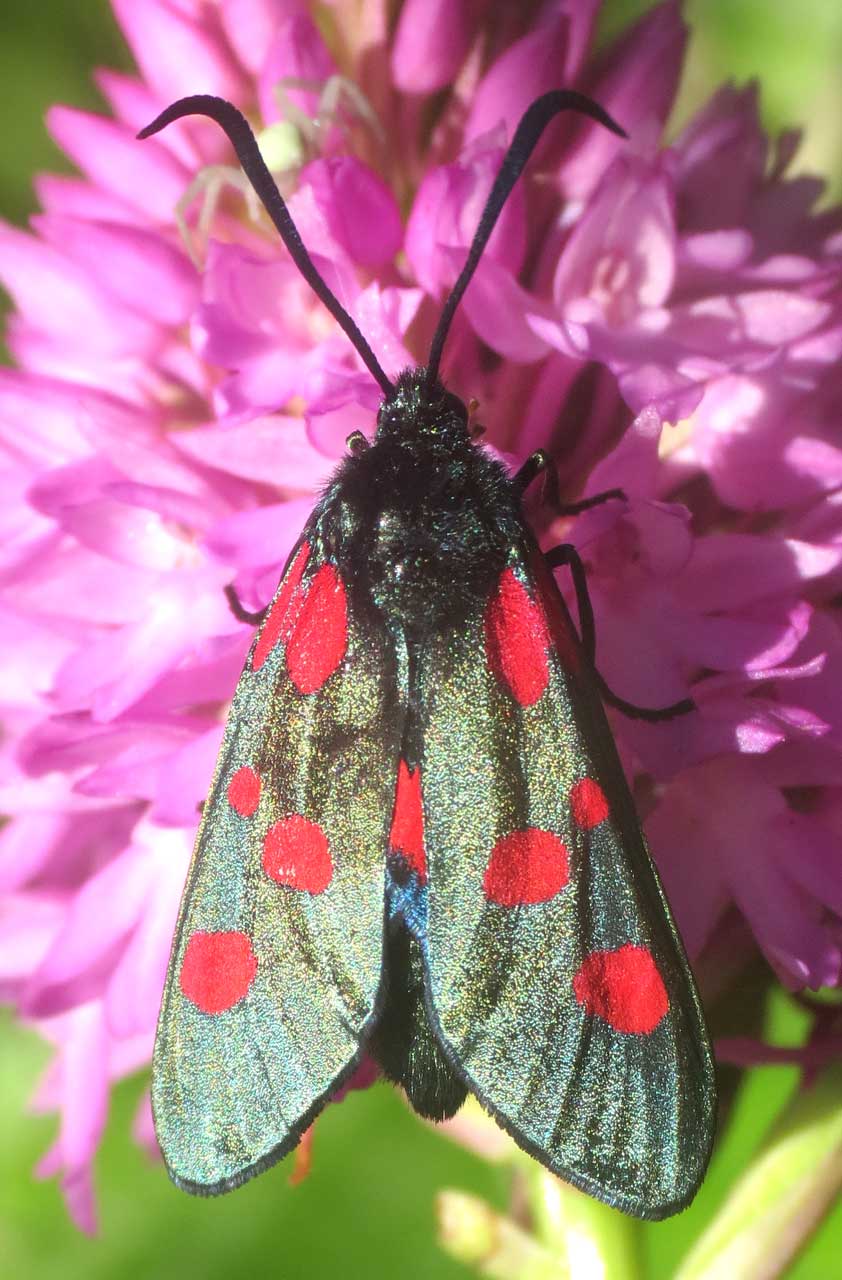 |
 |
 |
|
|
|
|
|
Highlight
of the day was my first ever confirmed Dark
Green Fritillary at the foot of Anchor
Bottom (near Dacre Gardens). It was one of two or three of this large
and very strong-flying butterfly. It was too fast and settled only briefly
and was far too quick for me to get a photograph in focus. However, even
the out of focus photographs showed the green patch on the underside of
the wings very clearly. Further east along Anchor Bottom, there was at
least one, probably two, very faded Painted
Ladies by the pair of Elderflower
trees. A Marbled White rose
from the shade of the largest tree. A Large
White Butterfly was seen near the gate
over the Creeping Thistle
and Ragwort (which
also proved attractive to the Small Tortoiseshells
and Meadow Browns
on Anchor Bottom). A
Small
Heath Butterfly settled on the western
side of the gate and a male Common Blue
fluttered over the main road outside Dacre Gardens.
A
Small
White Butterfly was seen in Shoreham.
Thirteen
species of butterfly (the most on one day this year)
7
July 2013
In
the warmth (25.9 °C)
of the midday
sun, my first Meadow
Brown
Butterflies of the year, with the first
day-flying Narrow-bordered Five-spot Burnet
Moths and probably the first Ringlet
Butterfly were seen over the verges of
the Downs Link Cyclepath 100 metres south of the Cement Works. There was
also a bright orange butterfly
that was not recognised to species. Subsequent observations and observations
at the time make this one almost certainly a Comma
Butterfly. Occasional Small
White Butterflies were seen over the outskirts
of Shoreham.
Adur
Butterflies: First Dates
Five
butterfly species
5
July 2013
Late
June (early
July this year as the flora and fauna is three
weeks late) is a latent period for butterflies
with few new emergences and only straggling imagos from earlier metamorphoses.
So
I would not have been surprised if my tally on nearly a warm day (>
19.0 °C) was low in species and numbers.
On the approaches to Mill Hill via the
top of the Pixie Path, a worn Red
Admiral made an over flight before settling
out of camera range. This was only butterfly seen off the downs in the
afternoon.
On
the southern steps down to the lower slopes of Mill Hill, a female Common
Blueimmediately
landed on a Bird's Foot Trefoil.
About half a dozen further Common Blues were
seen on the lower slopes in the sunshine. Most of them were the blue males.
 |
 |
 |
|
|
|
|
Small
Heath Butterflies were everywhere and
in excess of twenty were seen evenly spread over the lower slopes with
one on the top part of the hill. A flash of brilliant blue and that was
the first of about six fine condition male Adonis
Blues. They were joined by a Large
White. The Tor
Grass on the lower slopes was growing taller
than usual. I debated whether this would provide roosting conditions for
butterflies when a very restless Marbled
White was seen for the first time this
year. In the humid energy sapping conditions, I returned by the quickest
ridge route wHere two fresh Speckled Woods
courted in the shade of the scrub. On the steep slopes below the top of
the ridge a pair of courting Small Tortoiseshells
visited Thyme
and Self-heal before
settling out of camera range. Altogether five Small
Tortoiseshells were seen as another Large
White arrived.
Adur
Butterflies: First Dates
Eight
species
1 July
2013
Two
Large
Skippers either fighting or courting over
the overgrown path along the south bank of the Slonk
Hill Cutting was the highlight of a brief detour on a humid late afternoon.
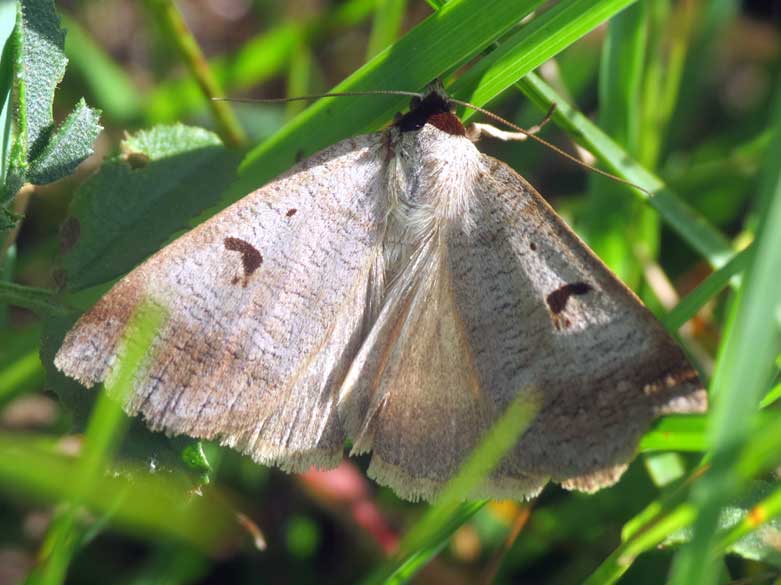 |
 |
|
|
|
Other
butterflies
on passage journey included a faded Red
Admiral in the shade of Buckingham Cutting
(south) and about twenty Small Blues
actually seen amongst the flowering
Kidney
Vetch on the open road verge with many more
hidden, and a Large White,
plus a large fawn Blackneck Moth,
Lygephila
pastinum.
Adur
Orchids
Adur
Skippers
Adur
Moths
Adur
Butterflies: First Dates
| 30
June 2013
Two Small Tortoiseshell Butterflies were seen over the verges of the cyclepath north of Old Shoreham (in the area where I thought I saw a Painted Lady a week earlier). A Small White Butterfly fluttered in the humid sunshine. |
27
June 2013
Breeze-blown
amongst waist high and sometimes shoulder high grasses on the more fertile
meadows at the top of Mill Hill, there
was hardly anything moving except the long grasses swayed by the south-westerly
(Force 4).
A small Small Heath Butterfly
was seen over the short turf and a faded Wall
Brown Butterfly landed on the path leading
north-east from the upper car park. Just I was debating the absence of
Common
Blues, a large fresh male opened its wings
in the meadow north of the upper car park. But it was the only one seen
as the sun went behind the many clouds.
 It
was never my intention to go to the lower slopes but just to have a quick
peek at the condition of the flora, and not expecting many butterflies
in the late-June
lean period. Small Heaths(15+)
were frequently as well as fresh blue male Adonis
Blues (12+) and many tattered males and
one worn female."A disappointing
number of butterflies," commented Colin
Knight. And then: "there is a Clouded
Yellow, it has landed right in front of
you!" By then I had put camera in the bag
and I was heading for home. Colin
spotted it first so it his prerogative to try and get first shot as I left
him chasing the immigrant butterfly up the very steep bank.
It was my first Clouded Yellow
I had seen for several years. Some (at least
3) of the blue butterflies on the lower slopes were male Common
Blues. At least one Treble-bar
Moth
was seen over the lower slopes.
It
was never my intention to go to the lower slopes but just to have a quick
peek at the condition of the flora, and not expecting many butterflies
in the late-June
lean period. Small Heaths(15+)
were frequently as well as fresh blue male Adonis
Blues (12+) and many tattered males and
one worn female."A disappointing
number of butterflies," commented Colin
Knight. And then: "there is a Clouded
Yellow, it has landed right in front of
you!" By then I had put camera in the bag
and I was heading for home. Colin
spotted it first so it his prerogative to try and get first shot as I left
him chasing the immigrant butterfly up the very steep bank.
It was my first Clouded Yellow
I had seen for several years. Some (at least
3) of the blue butterflies on the lower slopes were male Common
Blues. At least one Treble-bar
Moth
was seen over the lower slopes.
On
the way to the Mill Hill by footpath 3138 (which
was blocked by branches) there were two Speckled
Woods sparring over the Waterworks Road
and a Green-veined White
over Frampton's Field, Old Shoreham.
Seven
species of butterfly
23
June 2013
An
orange butterfly was buffeted by the breeze,
blown 20 metres one way and then the other so much I just got a single
close enough glimpse and it looked as though the only species it could
be was an immigrant Painted Lady.
This butterfly, seen over the Downs-Coastal
Link Cyclepath (just north north of the A27
Flyover) was the first one I have seen
for several years. The only other butterfly seen on an unsuitable day for
butterflies was a Large White.
Adur
Butterflies: First Dates
| 17
June 2013
Buffeted by a north-easterly Force 5, I felt I was nearly blown off the top of the Mill Hill after a struggle to cycle up. The top part of hill hosted many less butterflies than the current numbers on the lower slopes, notably five male Adonis Blues near the Reservoir, followed by a few Small Heaths, one Green-veined White, two Large Whites, a handful of Dingy Skippers, four Wall Browns and about ten newly emergent Common Blues including at least one female. These bright blue males may be the advanced guard before the imminent main emergence. One of the Wall Browns had large chunks missing from its wings. It visited Meadow Buttercups and Bird's Foot Trefoil. Small Whites were seen in Shoreham. Eight species |
 |
|
|
A sudden spell of sunshine in the late afternoon was unexpected after the morning rain.
With it came the butterflies, the first a Speckled Wood in the twitten between Corbyn Crescent and Adelaide Square (that posed for a photograph) followed by more than one Large White over Buckingham Park.
 |
 |
|
|
|
 |
 |
 |
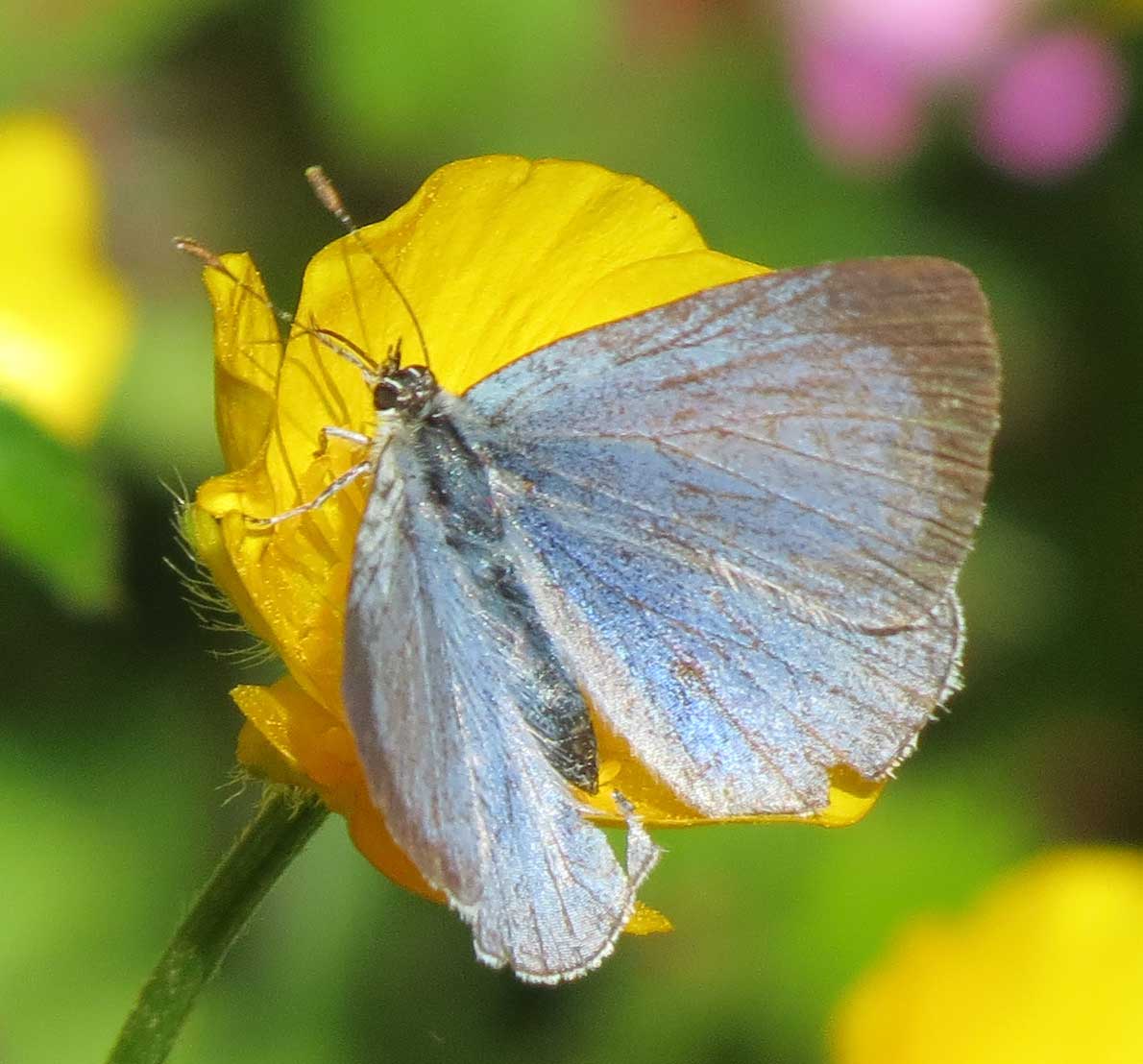 |
|
|
|
|
|
Just
before I entered the southern bank of Buckingham
Cutting, I noted in the time it came to count them 15 Small
Blue Butterflies roosting on grasses next
to the Stinging Nettles and Brambles on the south side of the footpath
approaching from the west. These tiny butterflies were fluttering all over
the embankment and in excess of a hundred in a garden plot patch of about
eight square metres. These were first I had seen this year. Also a first
of the year was a female Common Blue
perched on tall flower blowing in the breeze. This was followed by a male
Common
Blue and altogether I saw two of each gender.
The only other butterfly around in my brief stay was a Red
Admiral that landed on the path to be
seen clearly. On the way home two Small
Whites fluttered over Middle Road allotments
and lastly a Holly Blue
visited the Meadow Buttercups
in my front garden.
Adur
Butterflies: First Dates
Seven
species of butterfly; only one species was seen two days earlier
14
June 2013
A
sudden spell of sunshine after midday
was unexpected after the recent poor weather.
My
first definite Wall Brown Butterfly
of the year was seen on the Pixie Path 3138
to Mill Hill. It was the first of three in the same area, two which ended
up courting. I had already noted a few Holly
Blues and as I fought my through the overgrown
entrance to the footpath. One Wall Brown
was pale as shown in the picture and this one was courting with a brightly
coloured fresher looking butterfly. The third one was not so bright and
showed signs of damage.
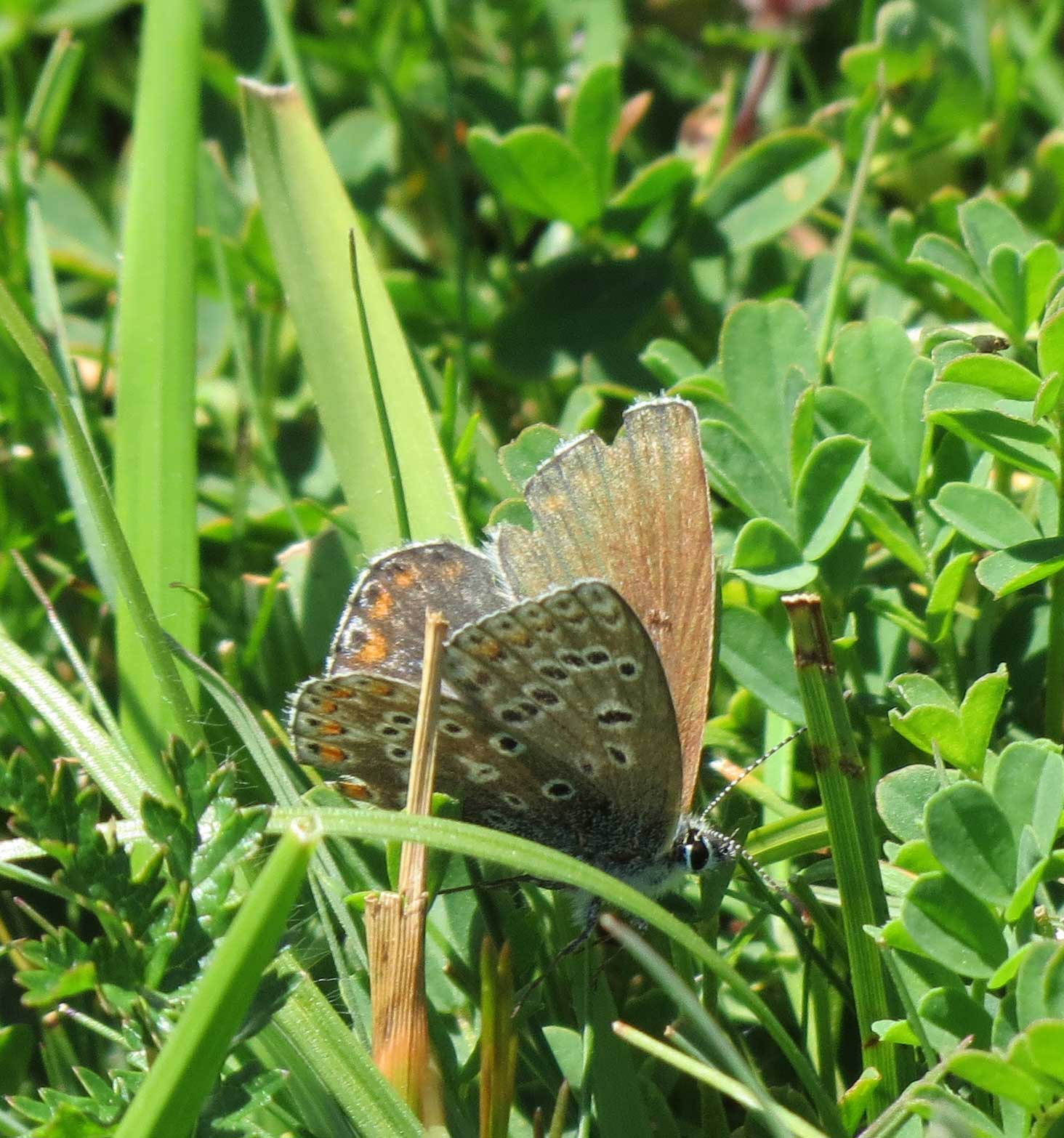 |
 |
|
|
|
|
On
the steps down to the lower slopes of Mill
Hill from the southern end, the first male Adonis
Blues were already easily seen their bright
blue clear amongst the remaining Horseshoe
Vetch, Hippocrepis comosa.
A Dingy Skipper was
seen immediately I stepped on to the slopes, the first of only about ten
in an hour. The 1.2 acre transect count of
Adonis
Blues
added
up to 113 (including 17 females). Female
Adonis
Blues received the attention of amorous males,
and a mating pair was observed in flight. Other females
crawled
amongst the Horseshoe Vetch
to lay their eggs. Other butterflies around
in the sunshine included frequent (20+) Small
Heaths, a bright yellow Brimstone,
a definite Green-Veined White,
as well as few Treble-bar Moths.
On the top of the hill south of the Reservoir a Silver
Y Moth fluttered amongst the tall herbs
which was rather like a rough pasture than a meadow.
Seven
species of butterfly
5 June
2013
With
scarcely a cloud in the clear blue sky, the
damsels
and demoiselles were seen on the outskirts
of Shoreham. Just three were seen of two different species most spectacularly
a male Beautiful Demoiselle, Calopteryx
virgo, on the Downs-Coastal
Link Cyclepath just north of the Flyover, and two Azure
Damselflies, Coenagrion
puella, on the Pixie
Path to Mill Hill. As expected on a
fine day, butterflies
were to be seen fluttering in the he breeze, notable occasional Speckled
Woods, Small
Whites, Green-veined Whites, Large Whites
and Holly Blues with
one male Adonis Blue (on
the southern upper part of Mill Hill).
This was all in under an hour.
3
June 2013
Although
not as luxuriant as the best years, the expanse of Horseshoe
Vetch, Hippocrepis comosa,
was
flowering
at its peak on the lower slopes of Mill Hill,
(north of Old Shoreham). The yellow patches could be seen from a distance
across the the other side of the wide valley. In the intermittent sunshine
under the fluffy Cumulus
clouds, butterflies
fluttered amongst the yellow flowers, notably the male Adonis
Blues in their first of two broods. In
the UK. this
medium-sized butterfly is only found on the chalk hills in the south-east
of England. I counted 79 in the 1.2 acre transect
on Mill Hill in half an hour, all the bright blue males apart from three
of the chocolate brown females. One mating pair was spotted in less than
ideal weather. Mill Hill Local Nature Reserve
is nationally renowned for its blue butterflies
which comes alive with the flutterings in the warmer months with at least
24 different species to be seen during the year.
 |
 |
|
|
|
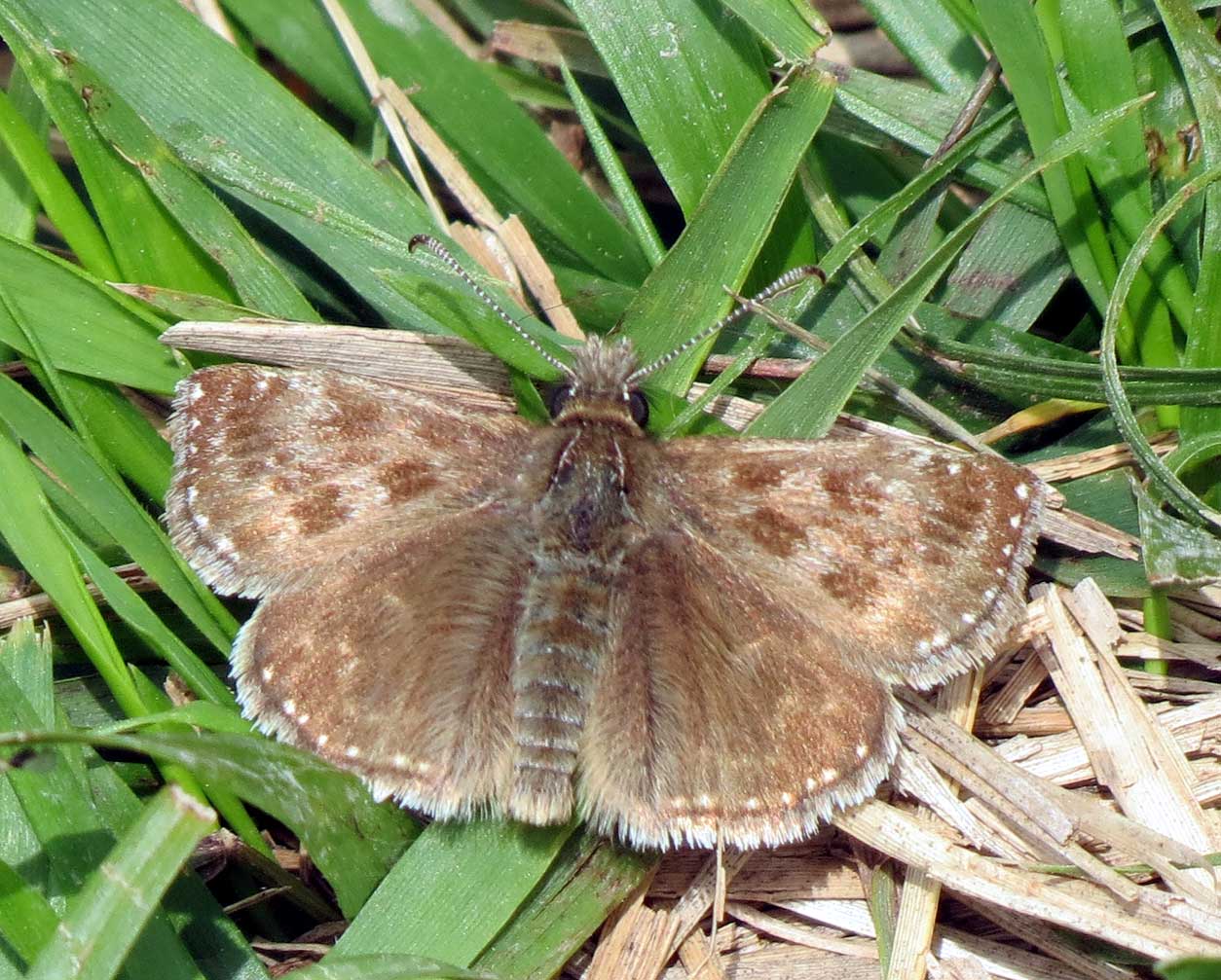 |
On
this early June
day, the Dingy Skippers were
frequently seen in the short chalkhill vegetation on the infertile Rabbit
cropped steeper slopes. There were also the Large
Whites, the large bright yellow Brimstone
Butterfly and the inconspicuous Grizzled
Skipper. The tiny flash of orange was
the Small Heath Butterfly.
There were many more butterflies outside of the transect area including the female Adonis Blue (photographed above) as well as a Treble-bar Moth. There were no Small Blues to be seen on Buckingham Cutting (verge of the A27 Cutting) but there was a Green-veined White and a Speckled Wood. At least one Holly Blue Butterfly flew around the hedges in Shoreham town. Eight species |
|
|
31
May 2013
The
first local Small Blue Butterfly of
the year was spotted and photographed on the north side
of the A27
near Shoreham.
Given
the success of my visit to the chalk cuttings on the A27
between Brighton and Lewes, I decided to walk
along the same road to reach the chalk cuttings to the east of Mill
Hill. I have to say that more than once
did I question my sanity for doing so because the traffic was racing past,
very dangerously. However, I wore my yellow high vis jacket and checked
out each of the three cuttings in turn. In all cases no chalk downland
butterflies were seen at any height above road level. The nearest one to
the Mill Hill entrance (TQ 21309 06603)
yielded a Dingy Skipper,
a Common Blue
and a Small Blue. All were very hard to see because of the turbulence
made by the traffic and the noise was deafening to. Where possible I avoided
being too close to the road's edge and at the next location (TQ
21491 06627) I watched a female Brimstone
flitter around a piece of scrub, in a mess of bramble. It was only when
I got up close that I realised that it was some Buckthorn that was attracting
her attention and I was delighted to watch her litter the shrub with eggs.
I also saw a Green-veined White
and two Peacocks
here.
The
next chalk cutting (TQ 21971 06637)
gave up a couple of Small Blues, two Common
Blues and a Brown
Argus
(hovering
around the tiniest clump of
Geranium).
The final cutting (TQ 22438 06608)
volunteered a single Common Blue.
I have to say that I was very surprised that so few butterflies where seen
(beyond the ubiquitous Small Whites and Large
Whites). The banks were densely covered
with Horseshoe Vetch
but not a single Adonis Blue
was seen. Having said that no Kidney Vetch
was observed but the sites still yielded Small Blues? The banks didn't
have much else on them apart from the Horseshoe
Vetch and Cotoneaster
bushes. So if you want to see what bounty chalk cuttings can give, go to
the one west of the Jet garage on the A27 between Brighton & Lewes.
There are some good butterflies there and more to the point the site is
separated from the road by a pavement, making it infinitely more safe than
the sites I described above. I would not recommend anybody else repeating
the exercise I undertook.
27
May 2013
With
the sun came the butterflies. On the approaches
to Mill Hill there were frequent
Holly Blues and occasional
Speckled Woods and a few Small
Whites. I also spotted my first of the
small
blue damselflies on the Pixie
Path but I was disturbed and I could not identify it to species. The
lower slopes of Mill Hill were covered in a 50% flowering
of Horseshoe Vetch, Hippocrepis
comosa,
but
it was still a minute before the first of about 20 Small
Heaths showed. This butterfly does not
open its wings (visible to the human eye) but settled with wings closed
aligned to the sun. A few pairs were amorous. After two minutes my first
male Adonis Blue
of the year fluttered energetically around the yellow flowers without settling.
It was one of 14 counted. Dingy Skippers
were slightly more prevalent than the Adonis
Blues but I did not count them.
 |
 |
 |
|
|
|
|
Two
Grizzled
Skippers were spotted and these were both
extensively damaged and faded like most of the other few seen this year.
In contrast the handful of Brimstone Butterflies
were bright and lively. There was also a probable Wall
Butterfly but I did not get a close look,
so it cannot go down as my first of the year.
Nine
butterfly species
26
May 2013
Butterflies
around Shoreham and Lancing and the outskirts were Large
Whites, Small Whites, Green-veined Whitesand
Holly
Blues.
I
was pleased to see hundreds of the red Yellow
Meadow Ants, Lasius
flavus, amongst the Common
Vetch. These ants can play a useful part in
the life cycle of the Chalkhill Blue Butterfly.
"Like
many other Lycaenid larvae, the Chalkhill Blue has a Newcomer's
gland on the 7th segment, the secretions from which are highly attractive
to ants which then afford the larvae some protection against predators.
The larval stage lasts between 9 and 10 weeks."
UK
Butterflies: Chalkhill Blue
| 23
May 2013
Five Green-veined Whites and one male Orange-tip were spotted on the Waterworks Road. Then it started raining (which stopped my visit to Mill Hill). |
 |
22
May 2013
I
visited the lower slopes of Mill
Hill. Although the weather was overcast
with a cold wind, there were occasional sunny intervals .I saw the first
Adonis
Blue of the season, but only one around.
Others seen were Grizzled Skipper
(1), Dingy Skipper
(3), Small Heath
(5), Green-veined White
(3).
 |
19
May 2013
The first Wall Brown of the year was seen on Mill Hill in very overcast & intermittently drizzly weather. Report
by Kelly Westlake on Sussex
Butterflies
|
17
May 2013
On
an overcast afternoon I visited Mill Hill
but virtually all the butterflies on the
lower slopes were hiding. I managed to see my first Small
Heath Butterfly of 2013,
a damaged pale Grizzled Skipper,
and I disturbed my first Dingy Skipper
and Cinnabar Moth
of the year.
 |
 |
 |
The
pyralid
moths
were frequently seen especially Pyrausta
nigrata but only one definite of the
colourful Pyrausta purpuralis.
I also spotted an occasional even tinier Violet
Comet Moth,Pancalia
leuwenhoekella.
Adur
Butterflies: First Dates
11
May 2013
A
Speckled
Wood Butterfly visited my front garden
in Corbyn Crescent, Shoreham.
7 May
2013
Green-veined
White Butterflies were confirmed for the
first time this year sparring with male Orange-tips
on the footpath section of the Waterworks
Road, Old Shoreham.
Adur
Butterflies: First Dates
 6
May 2013
6
May 2013
The
sunshine brought out the bumblebees
and butterflies. Holly
Blue Butterflies and Small
Whites fluttered over town
gardens. On the outskirts of Shoreham I recorded my first Speckled
Woods, courting over the top of Chanctonbury
Drive (SE of Mill Hill Road Bridge over the A27).
It was not until the first week of May
that I noted a handful of the yellow flowers
of Horseshoe Vetch, Hippocrepis
comosa, (when
this important caterpillar plant would be expected to flower beginning
in the middle to late April).
The late flowering is likely to be responsible for the
dearth of butterflies on the lower slopes of Mill
Hill. I did manage to spot a pair of amorous Grizzled
Skippers for the first time this year,
as well as more Speckled Woods,
the inevitable Peacock Butterflies,
one wandering male Orange-tip
and a probable Red Admiral.
A
few tiny pyralid moths
were spotted, one each definitely of Pyrausta
nigrata and the colourful Pyrausta
purpuralis.
Seven
butterfly species
NB:
The flowering times of wild plants and shrubs, and the appearance of the
first butterflies seems to be three weeks behind an average year.
On the warmest day of the year so far so I headed to Mill Hill to do my butterfly transect in optimistic mood. It started well with a Small Tortoiseshell crossing my path as soon as I started my walk. I recorded several firsts for the year: 1 Green Hairstreak, 4 Grizzled Skippers and 1 Dingy Skipper, plus 3 male Brimstones, several whites, including a Large White, a male Orange-tip, a Red Admiral, 6 Peacocks and 2 Speckled Woods. I spotted a few micro moths: Pyrausta nigrata, a Small Purple-barred Moth Phytometra viridaria and a tiny Pancalia leuwenhoekella.
3
May 2013
Hardly
a cloud in blue sky, and the bees
and butterflies were
out in the weak sunshine. A flutter of a restless
Holly
Blue was the first butterfly to be seen
over the Waterworks
Road, Old Shoreham. This was quickly followed
by my first definite of the year Large
Whites followed by a male Orange-tip.
A Peacock Butterfly
flew over the cyclepath north of Old Shoreham. A Small
White was seen in Shoreham town and the
photographs revealed the small whites on the Waterworks
Road to be these as well and not Green-veined
Whites.
Five
definite species
Adur
Butterflies: First Dates
1 May
2013
A
few firsts of the year were recorded as the
sun came out. The first of a few Holly
Blue Butterflies were seen over the Waterworks
Road, Old Shoreham followed by a Small
Tortoiseshell on Footpath
3138 Pixie Path to Mill
Hill. At the top by the bridge over the A27
I spotted my first Brimstone Butterfly
of the year. The lower slopes of Mill Hill were covered in scattered clumps
of Dog Violets
visited by Peacock Butterflies
and a patrolling Brimstone Butterfly
one Small Tortoiseshell and
a single Comma
at the northern end. I looked for but could not find a single Horseshoe
Vetch flower
which means they are late this year. White
butterflies were occasionally seen and were
too far away to decide if they were Small
Whites, Green-veined Whites or Large
Whites and possibly all three.
Six
to eight butterfly species
Robin
Lord reported (and photographed) the first
Grizzled
Skipper of 2013
on
the lower slopes of Mill Hill
but I saw no sign of it.
Adur
Butterflies: First Dates
25
April 2013
I
did my butterfly transect at Mill
Hill and was surprised that the Dingy
Skipper was still not out. It is now a month
late compared with last year. There were
plenty of Peacocks
fighting at the bottom of the hill, plus some Small
Tortoiseshells and male and female Brimstones
(first
of the year) and a Comma.
 |
22
April 2013
At least two Comma Butterflies were seen over the Waterworks Road. |
21
April 2013
Butterflies
were seen in double figures for the first time this year: ten Peacock
Butterflies (seven over the lower slopes
of Mill Hill and the others amongst the scrub), three Comma
Butterflies over the lower slopes, and
one Red Admiral
under the cover of the copse at the top of the hill, were seen in about
an hour. One tiny pyralid
moth
was spotted, probably Pyrausta despicata.
20
April 2013
A
Small
White Butterfly flew over Corbyn Crescent
in residential Shoreham.
19
April 2013
My
first confirmed hoverfly
of the year was a Drone Fly, Eristalis,
but I have missed a few in the last few days. Over the Curlews (a close
in Shoreham near Hamm Road Allotments) I spotted a white butterfly
fluttering in the distance and it was almost certainly a Small
White Butterfly.
15
April 2013
A
second day of weak sunshine and a few insects
were buzzing around: they were recognised as the first Comma
Butterflies seen this year over the Waterworks
Road. (The footpath
was still fenced off). These
will be new emergences.
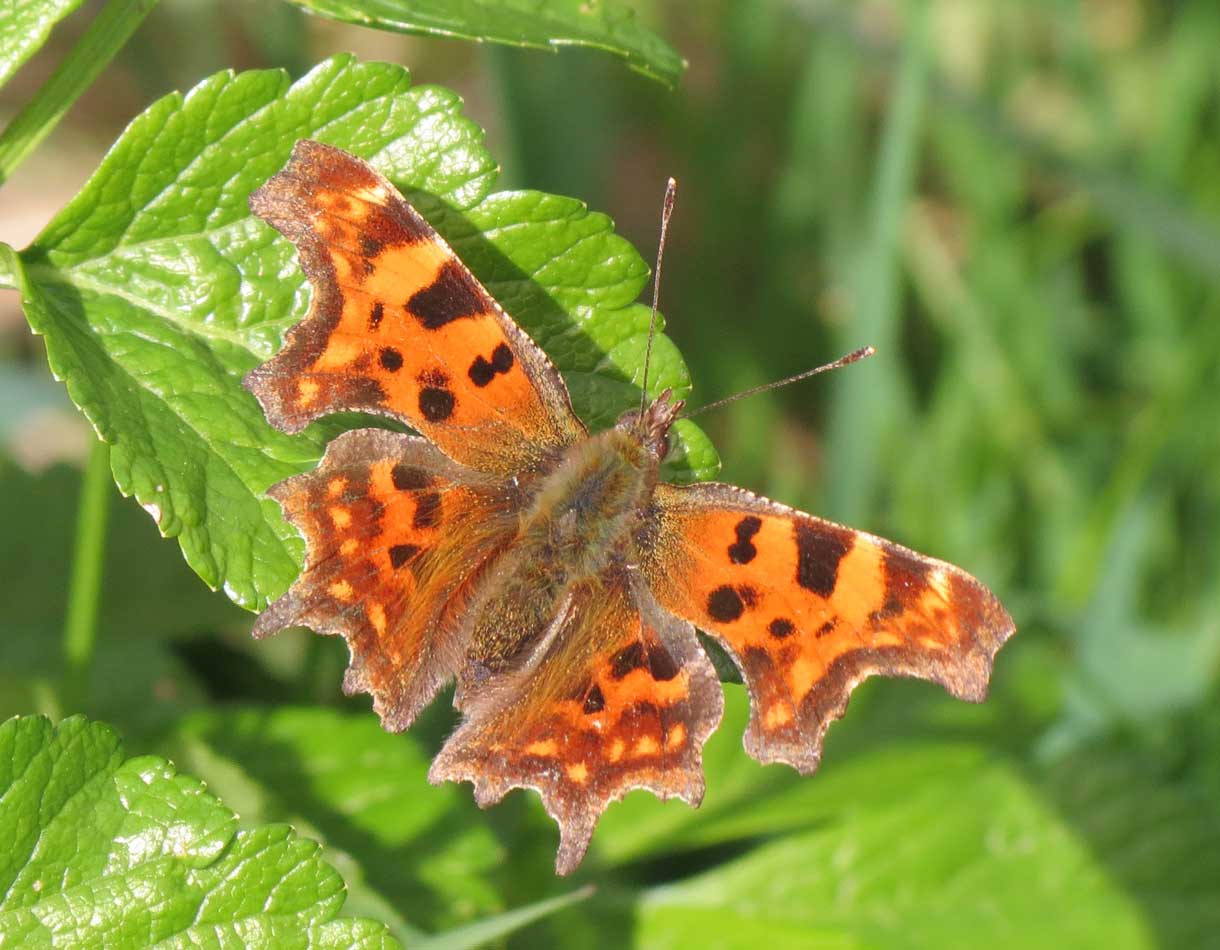 |
 |
|
|
|
On
the cyclepath south of the Toll
Bridge another butterfly flew rapidly
in the breeze. This
settled as well and was discovered to be a Peacock
Butterfly which
would have come out of winter hibernation.
In the afternoon, three Small Tortoiseshell
Butterflies were seen over the Middle
Road Allotments from the track that runs along the western boundary.
Adur
Butterflies: First Dates
2 April
2013
A
Small
Tortoiseshell on Lancing Manor Allotments
late this afternoon.
For
just a few minutes I felt he brief and weak warmth of the sun from between
the white clouds, as I was battered by a chill north-east breeze (Force
5 gusting to Force 6).
A
few spring flowers were noted for the first time. And late in the afternoon
I spotted only my second butterfly of the
year, a slightly tatty Small Tortoiseshell
on Stinging Nettles on the path to the west of Middle Road Allotments,
Shoreham.
Adur
Butterflies: First Dates
18
February 2013
I
was surprised to see my first butterfly
of the year. A fine Peacock Butterfly
rose from the path* amongst
the scrub on Mill Hill and away over the
Old
Man's Beard.
(*Path on the continuation north from the lower slopes.)
Mill
Hill Report
10
January 2013
We
were amazed to see a Painted Lady Butterfly
flying north past Shoreham Old
Fort while out birding; our first butterfly
of 2013.
1
January 2013
A
Small
Tortoiseshell Butterfly was seen in flight
in the afternoon sun at the south west corner of the Adur Recreation ground,
Shoreham-by-Sea.

